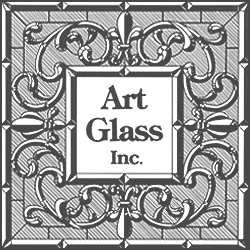
Stained Glass
Art Glass, Inc. constructed most of its stained glass windows using lead came and solder, the traditional way that first appeared over 1300 years ago. But even using modern wheeled glass cutters, light boxes, grozing pliers, electric soldering irons, and stock lead caming, the work, all done by hand, required much labor, patience, and skill. Now and then Art Glass would use the copper foil technique that Louis Comfort Tiffany's studios pioneered in making his famous stained glass lampshades. While most of its larger stained glass commissions were for religious congregations, Art Glass also served many restaurants and other businesses, military installations, and residences. Plus it did a considerable amount of stained glass restoration and repair work.

The simple hand tools of the trade
Religious Windows in Various Styles
First, a note about the pejorative expression "stained glass Christianity" — as opposed to what, the unembellished "real thing"? But stained glass was only a small part of great cathedrals, as well as it is of many modern-day churches. Of course, the holier-than-thou indictment is that money can always be spent in better ways, for example, helping the poor. But as Jesus might also have said, let him who is without sin examine his or her own expenditures. Everyone — from artisans to church-goers — might better spend every instant of their time and every penny of their money running soup kitchens. And then might someone get the bright idea to add some stained glass to one of those kitchens?
The symbol laden windows of St. Aidan's Episcopal Church, though relatively simple and not very large as stained glass windows go, were probably my favorite church commission. I consider them my closest approach to the liturgical ideal of "teaching" stained glass. I met with the church's very dedicated window committee three times, for a total of nearly nine hours! But I found hashing out which symbols they wanted and didn't want quite enjoyable — even though my own recommendations didn't always prevail. It must have been the knowledge of the Bible and Christian symbolism I displayed that led St. Aidan's priest at the time to surmise that I was "a devout Christian steeped in the history of the Church..." which appeared in the text of the church's window brochure (see below). Actually, it's my doubts about the prevailing doctrines of Christianity that I'm most devout about. But "steeped" (as in full of something) seemed an appropriately worded tribute to my religious-school education.
— Ray Gregory
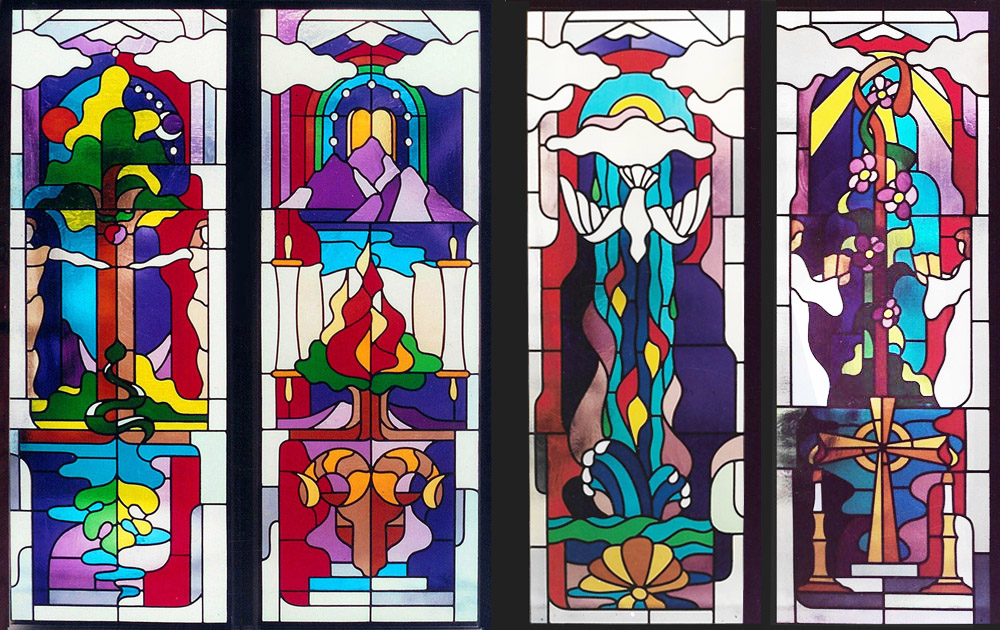
St. Aidan's stained glass brochure
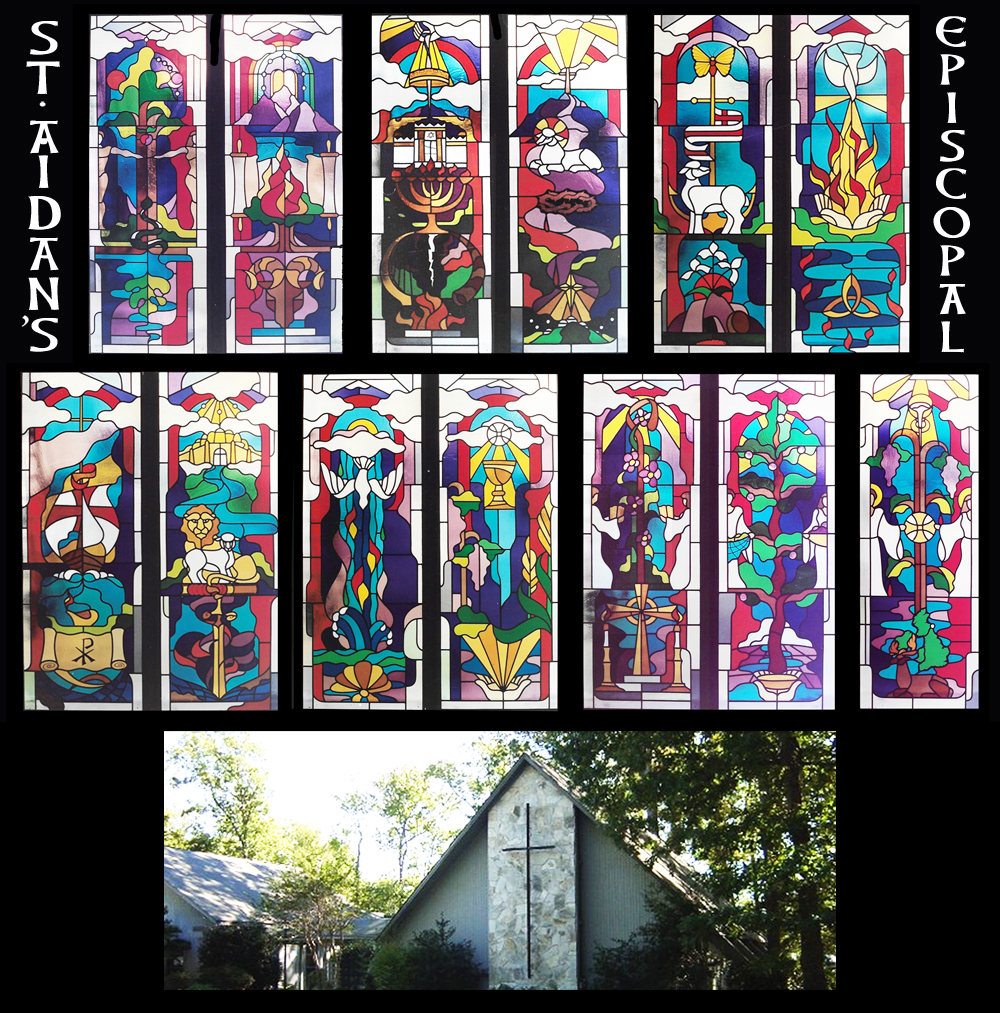
St. Andrew's Lutheran was another wonderful church to work for. The congregation wanted stained glass for its sanctuary aisle windows, but also wanted to enjoy the sunlit exterior view, so there was this pleasing compromise solution:
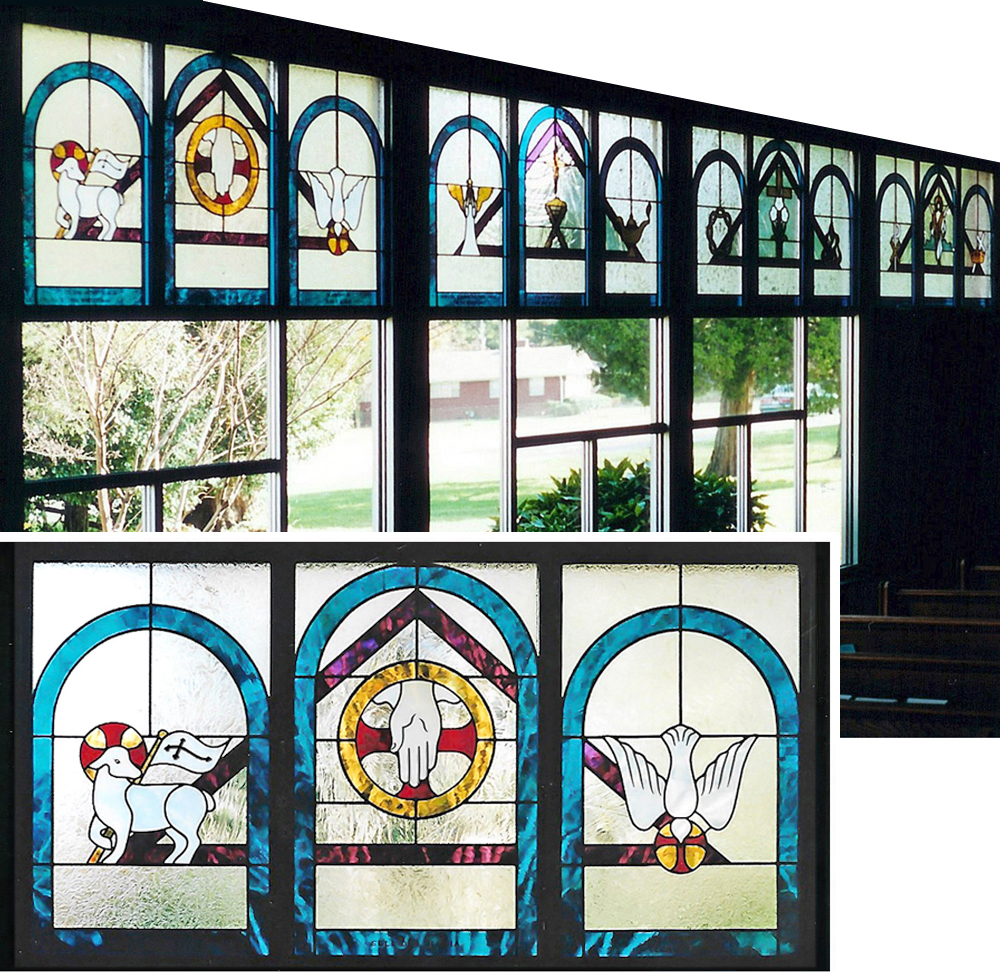
A couple of St. Andrew's entry windows
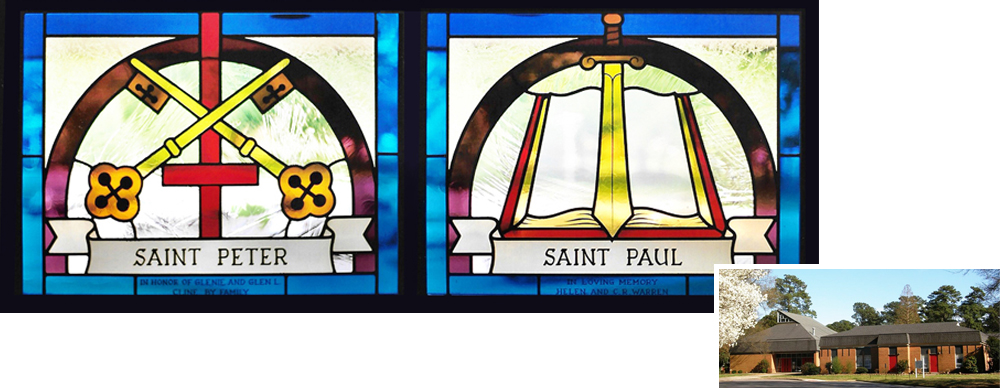
St. Andrew's, Lutheran, stained glass, Ray Gregory, Art Glass Resplendent, Norfolk, Churchland, Portsmouth, Virginia
Foundry UMC altar window (actually a large lightbox)
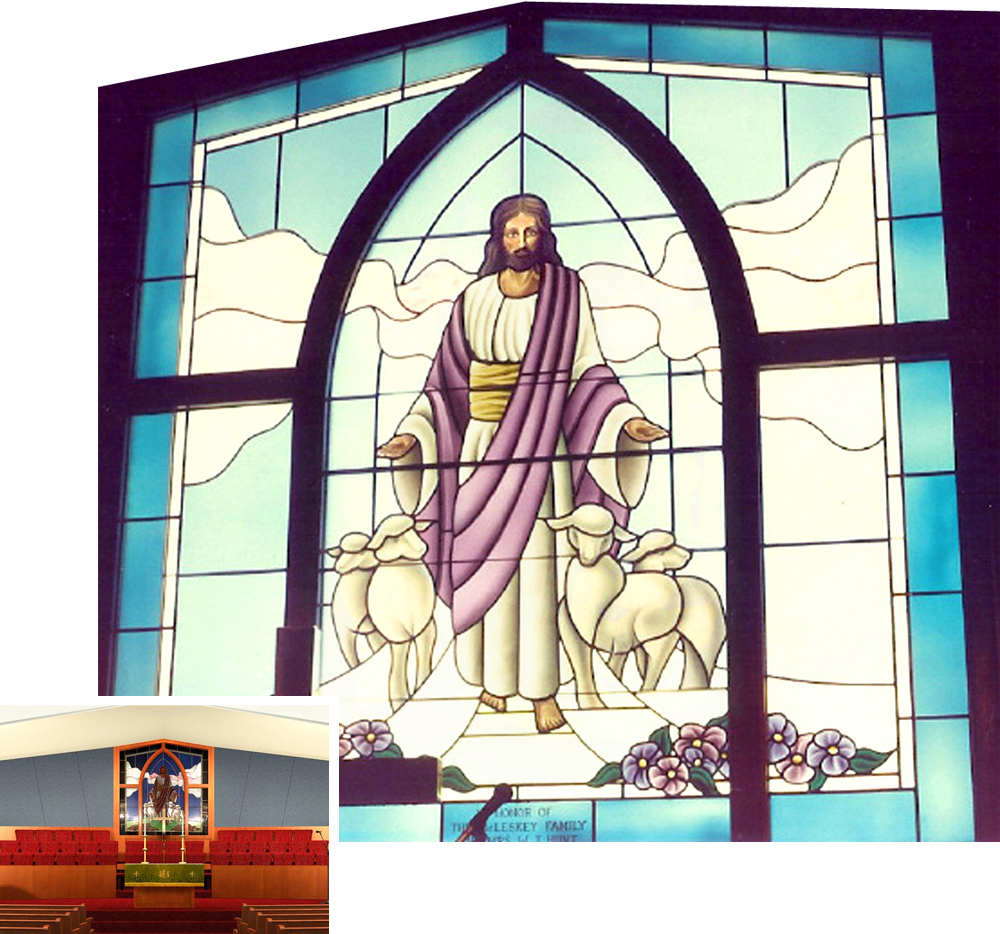
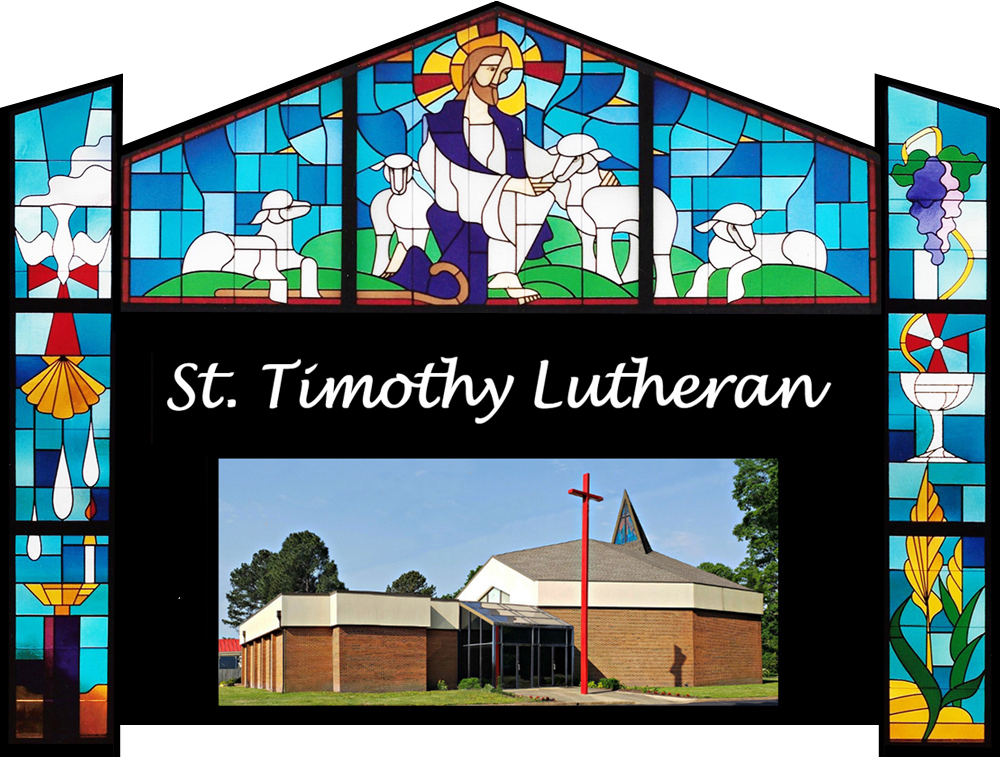
St. Mark's Catholic
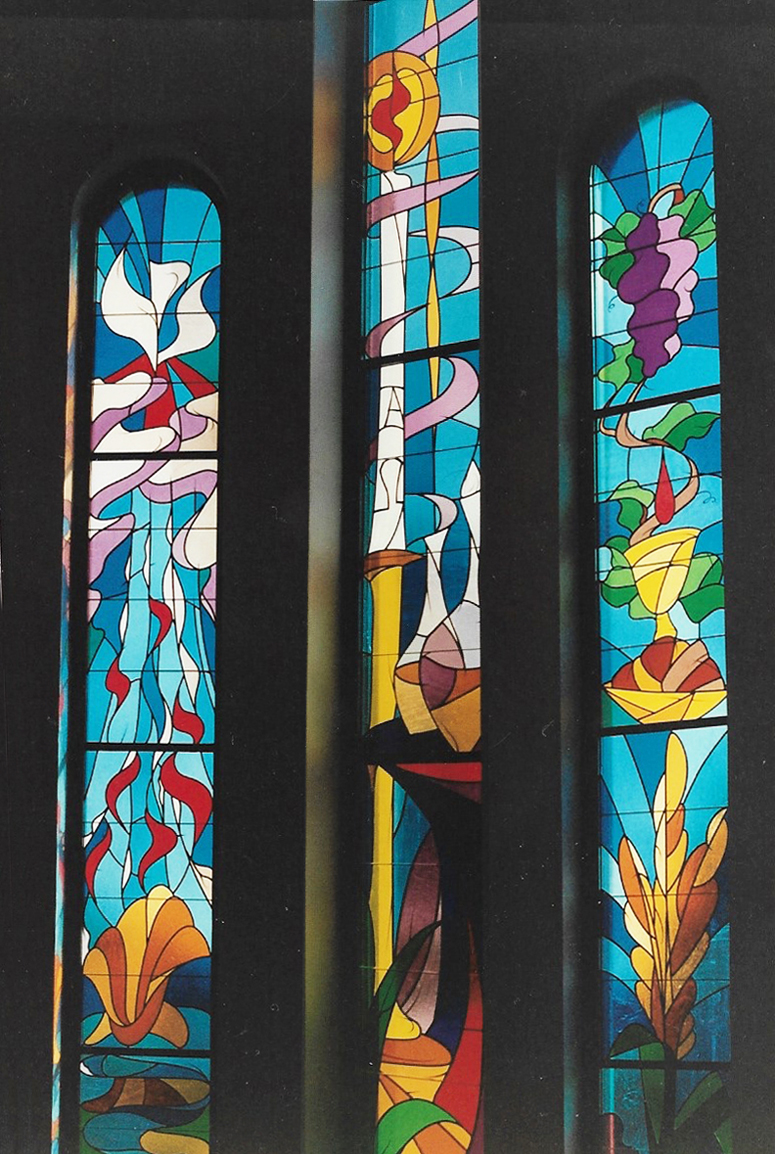
St. Mark's altar windows (abstracted scenes from the Gospel of Mark)
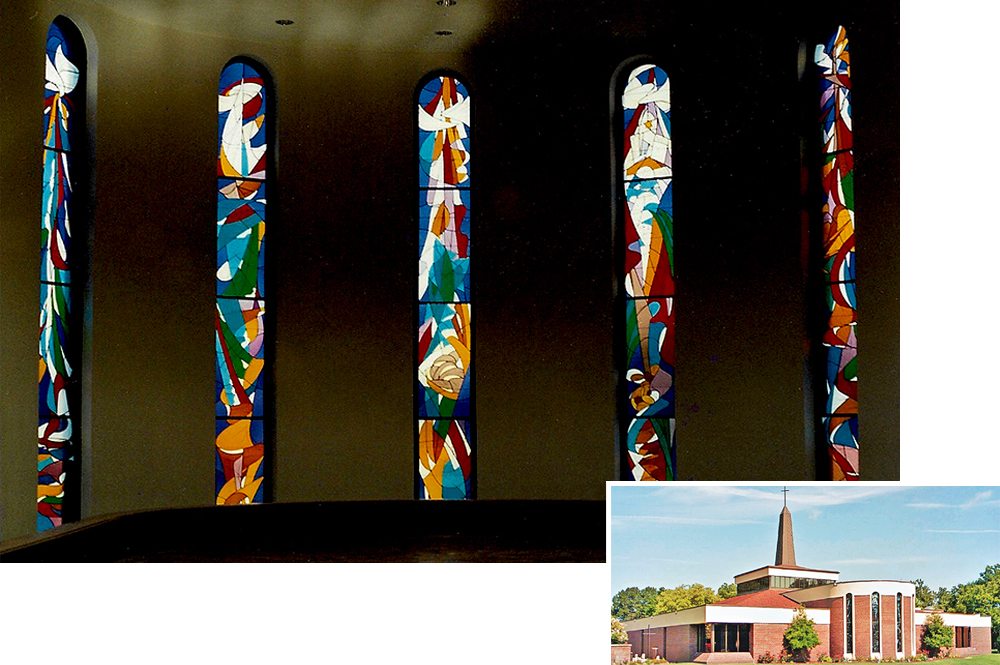
Many, many traditional-style windows
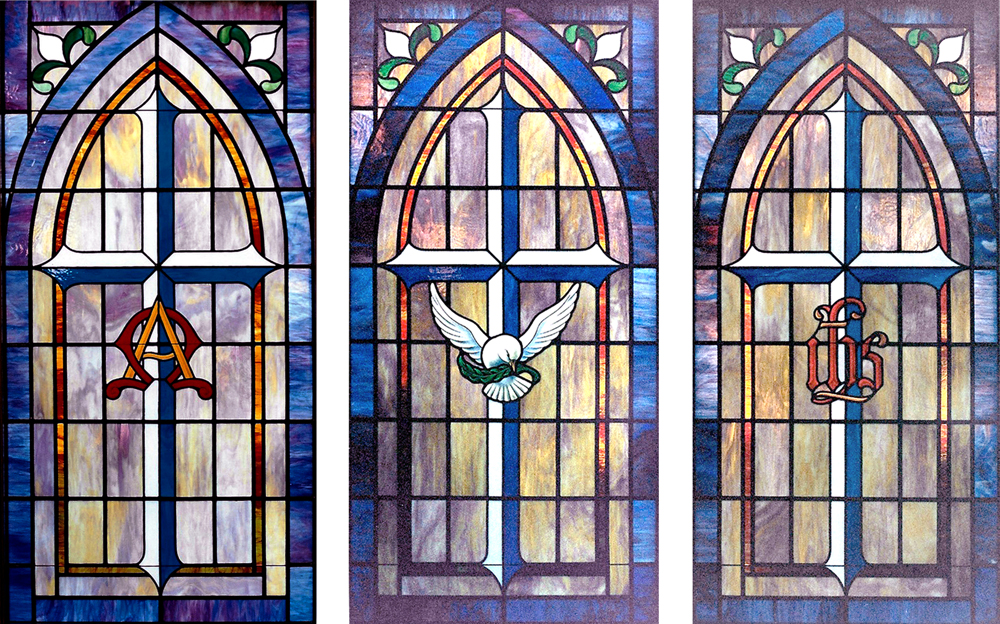
Hindu Diwali (Festival of Lights)
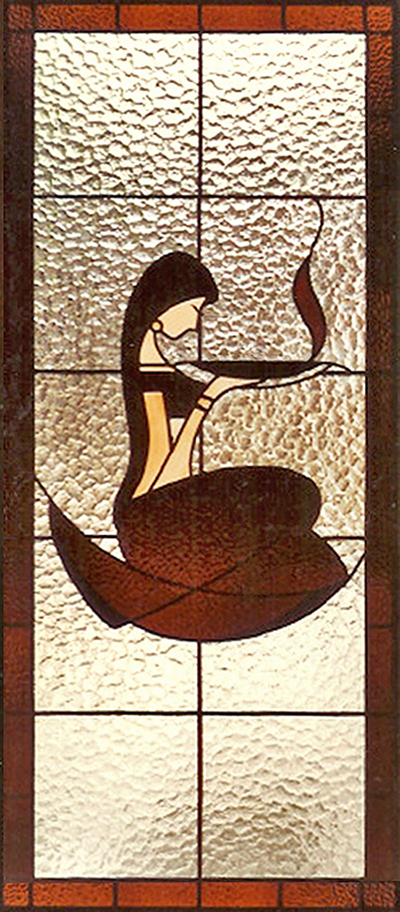
Naval Security Group Chapel
Chesapeake, Virginia
Art Glass produced five baptismal windows for renowned architectural glass designer David Wilson:
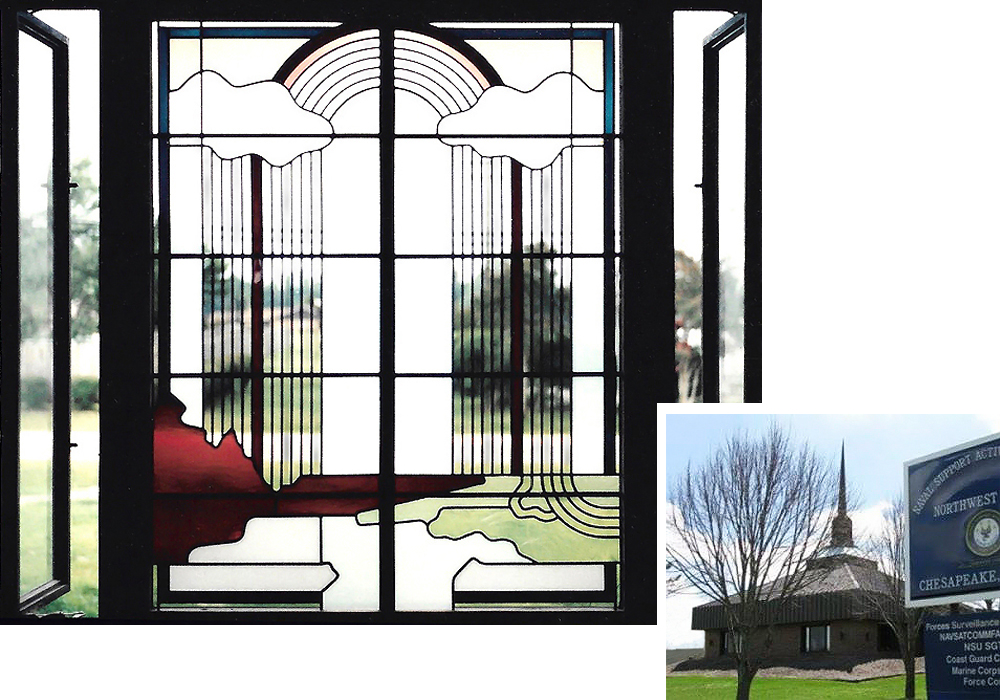
Rendering Wilson's intellectual and highly rectilinear designs in glass demanded meticulous craftsmanship — all those lines had to line up!

Naval Security Group, Chapel, stained glass, Chesapeake, Virginia
Washington Hebrew Congregation
Washington, D.C.
Art Glas, Inc. also produced and installed the stained glass for the "Wall of Light" (approx. 75 feet wide) designed by David Wilson for the sanctuary of the largest synagogue in the nation's capital:
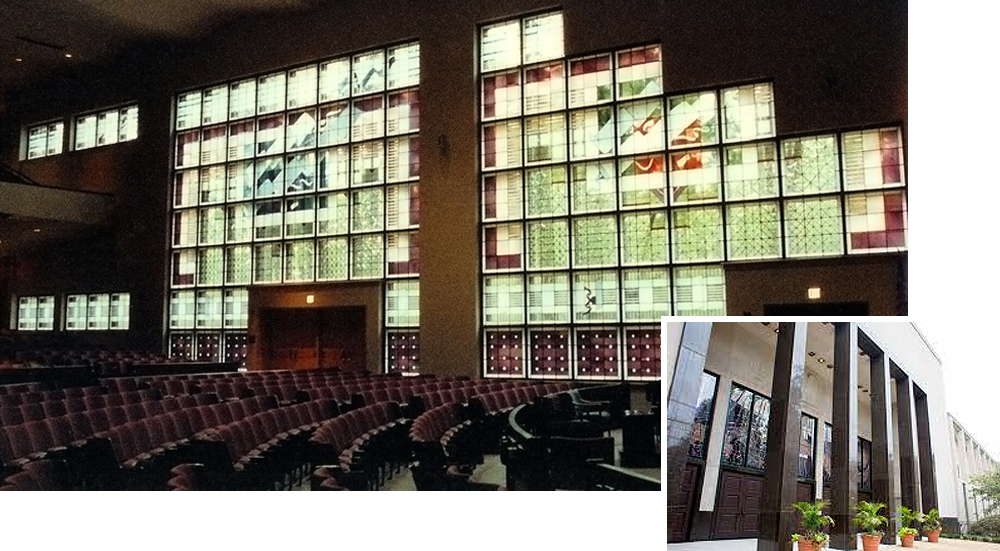
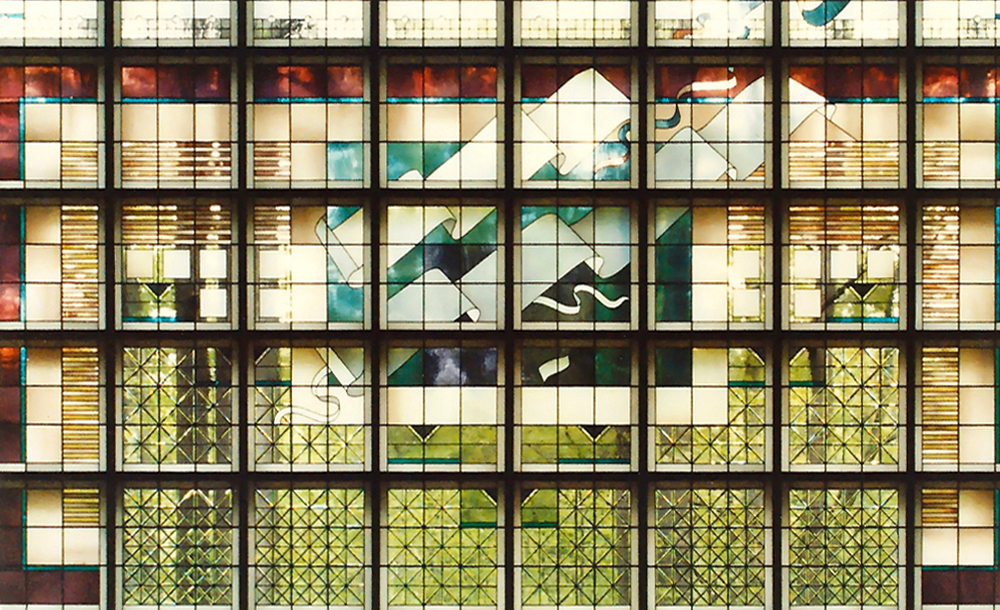
Naval Security Group, Chapel, stained glass, Chesapeake, Virginia
Glass Painting
Below, unpainted glass pieces lying on a light table and the finished painted and leaded-together stained glass panel. The vivid colors were mostly in the glass itself, with vitreous paints (blacks, grays, and browns) applied to add lines and shading effects, then baked onto the surface of the glass pieces in the kiln. But sometimes vitreous enamels were used to add colors. Glass stainers' paints are nasty stuff, containing all kinds of toxic heavy metals, but once fired onto the glass, they're trapped in the glass, no longer able to contaiminate the enironment. Each glass piece required from two to five (sometimes more) firings in the kiln to achieve the desired effect. Here the colors of tree trunk, flesh, rock, soil, and some of the flowers also came from the paints:
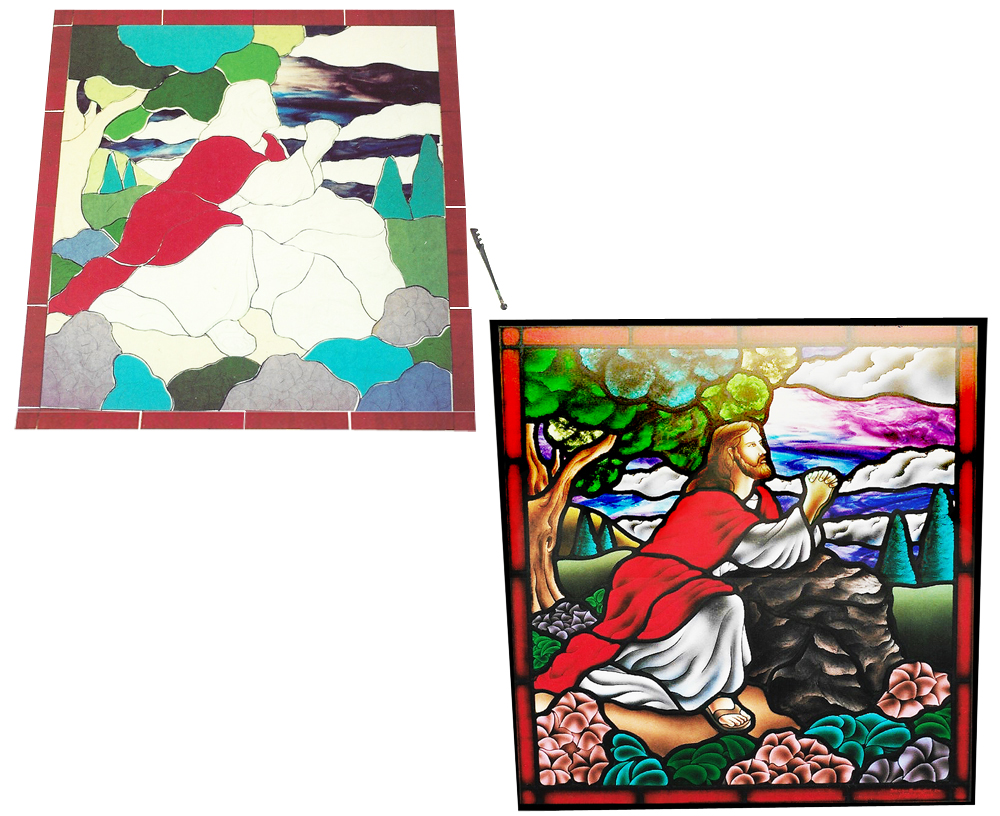
A Glass Painter's Lament
Isn't it best to let glass speak for itself, to let stained glass be its full glassy self and not some luminescent semblance of a painting on canvas? Glass painters call what they do "arresting the light on the surface of the glass," but it might also be called, especially when done to excess, a kind of travesty, an affront to the ideal of glass and light interacting.
But glass painting, which reached its peak of opacity in the nineteenth century, is now expected for the "traditional" look, especially in stained glass church windows. Of course, in those cases where glass is illuminated by a lightbox, painting doesn't crimp the nature of the glass any more than does the flat artificial light radiating from a translucent light diffuser behind it. Neither does painting significantly crimp the style of windows made mostly of opalescent glass, a milky glass you can't see things through, something else that became most prominent in the nineteenth century, especially in church windows.
— Ray Gregory
St. Theodore Chapel, Annunciation Greek Orthodox Cathedral
Norfolk, Virginia
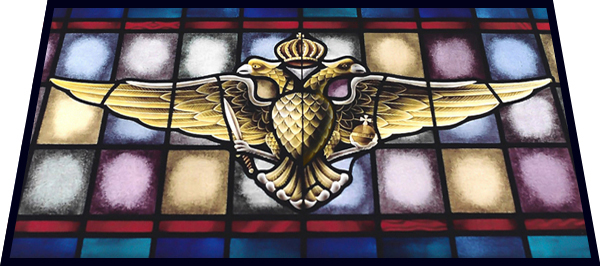
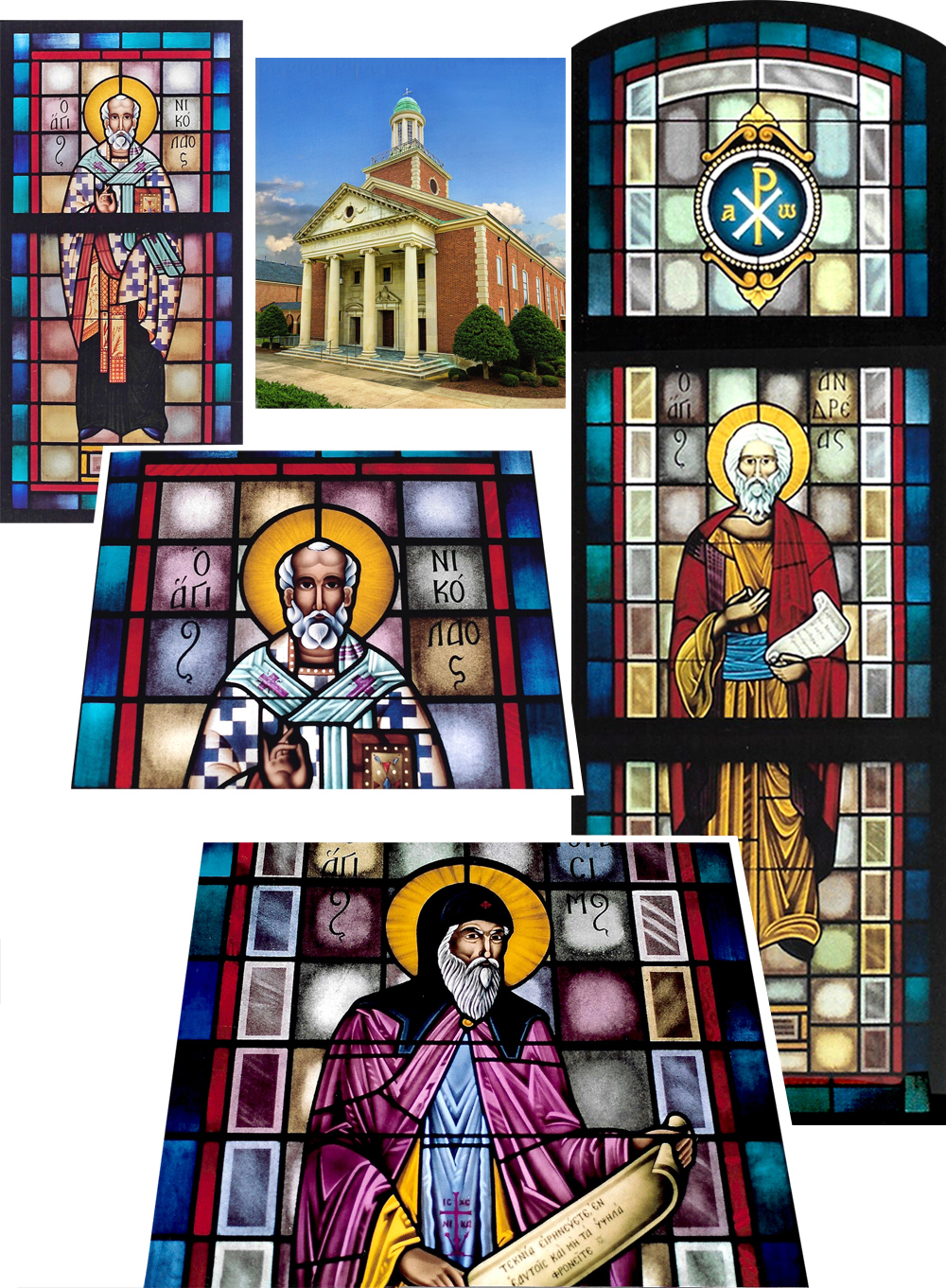
Naval Security Group, Chapel, stained glass, Chesapeake, Virginia
In the style of the old sanctuary windows
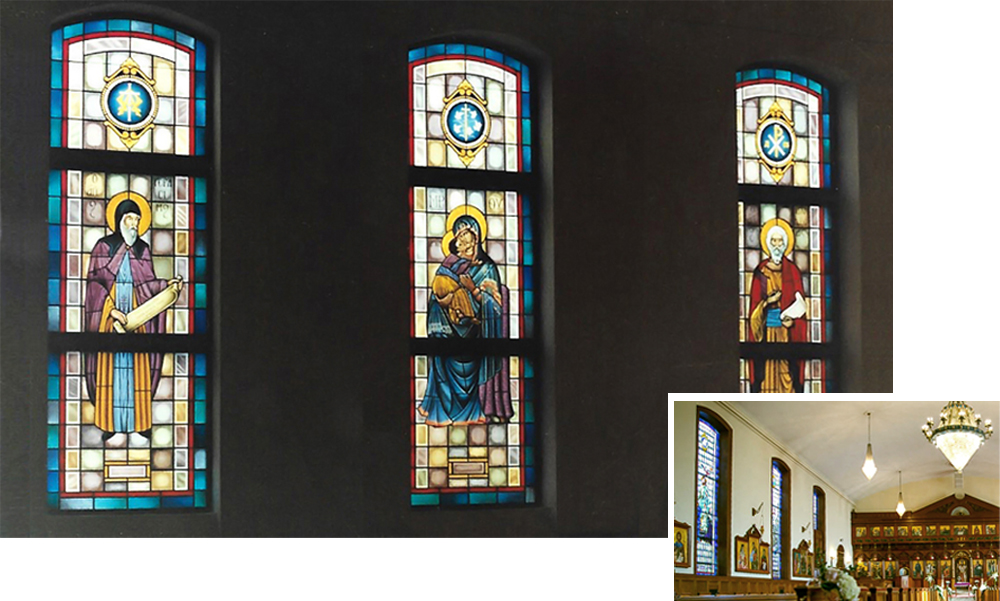
Painted (but not yet leaded together) glass pieces for an Orthodox window in a monastery in Greece:

Entryway glass for St. Matthew's Catholic
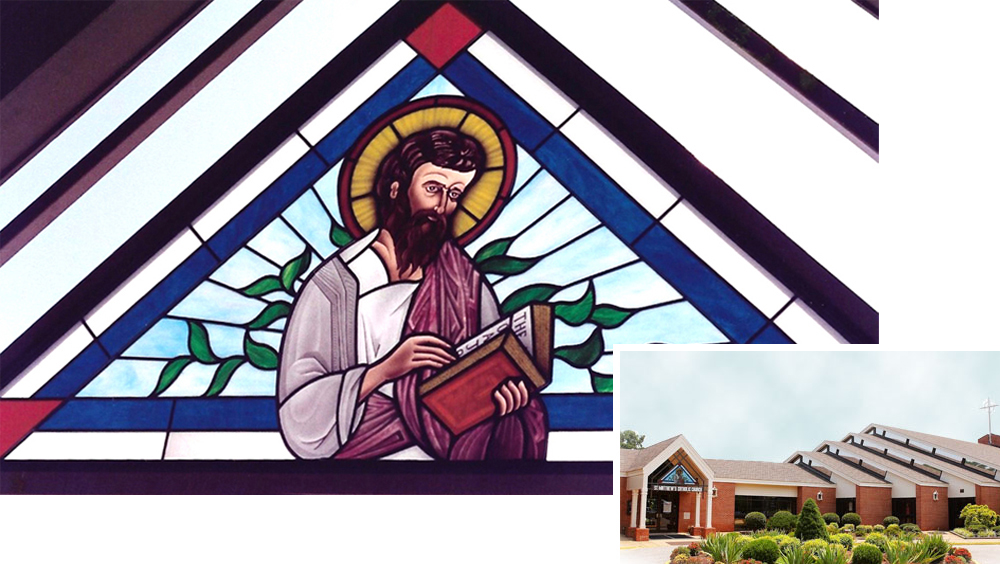
Children's Hospital of the King's Daughters Chapel
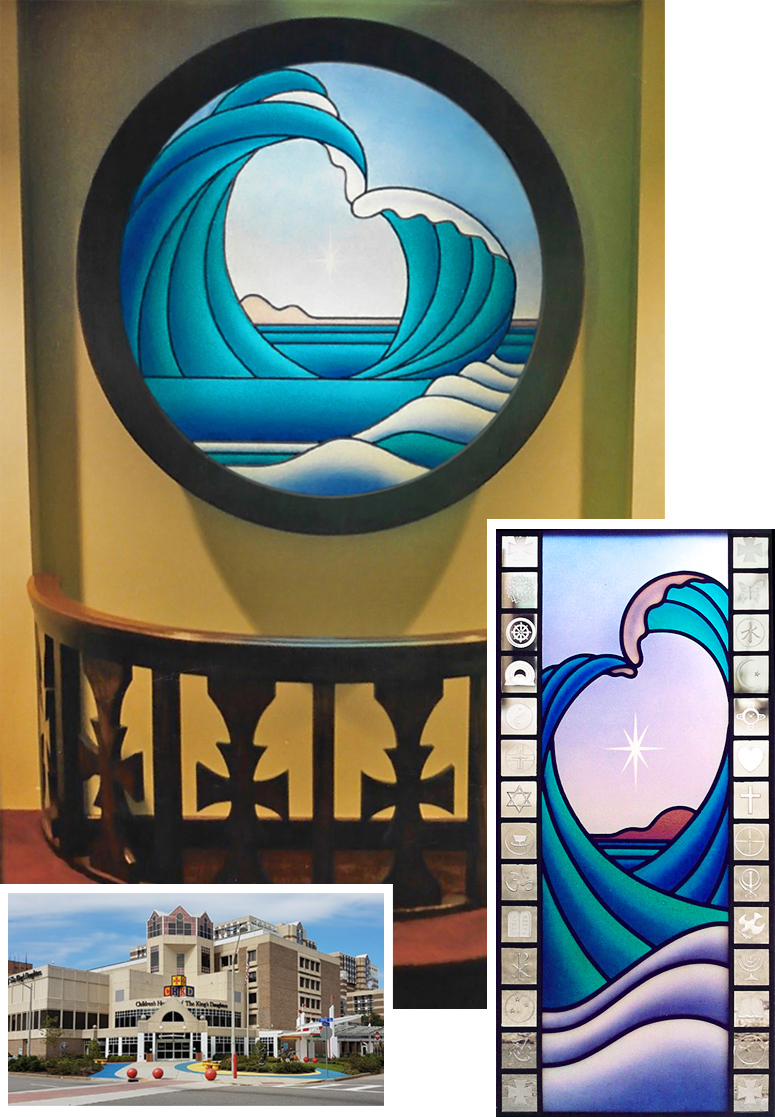
Some church window maritime medallions

Assorted painted church windows
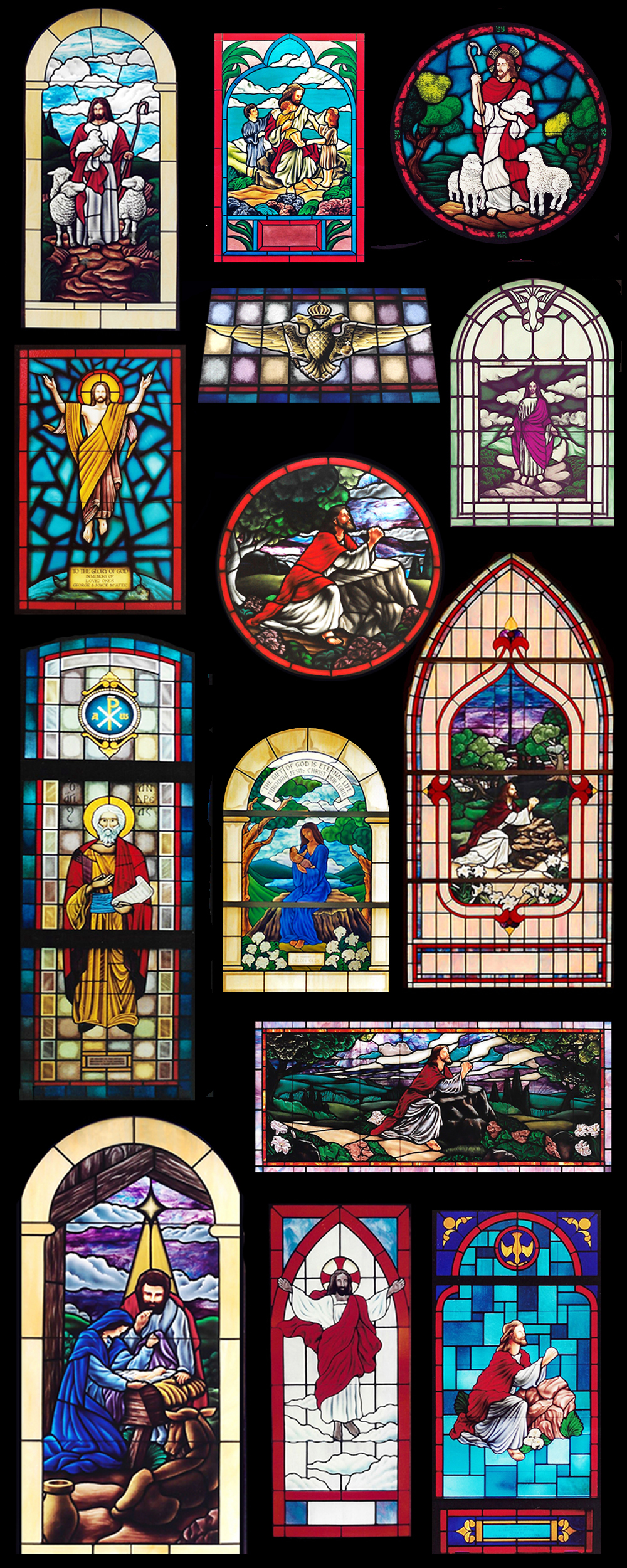
A veterans' mausoleum
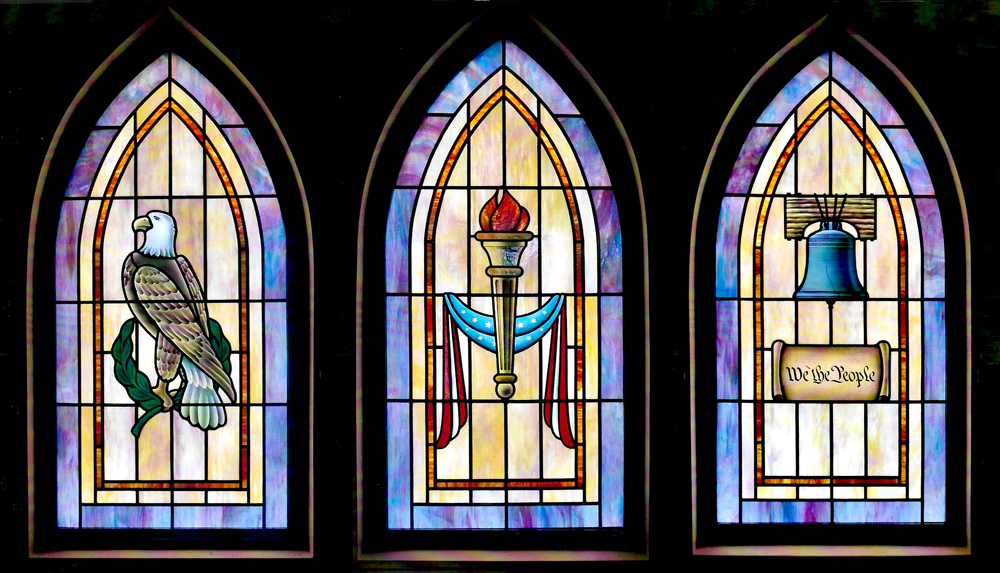
Mount Lebanon Baptist
These two went to Mt. Lebanon Baptist Church in Brooklyn, New York, the farthest north Art Glass ever went to install stained glass. Mt. Lebanon's preacher at the time hailed from the Hampton Roads area.
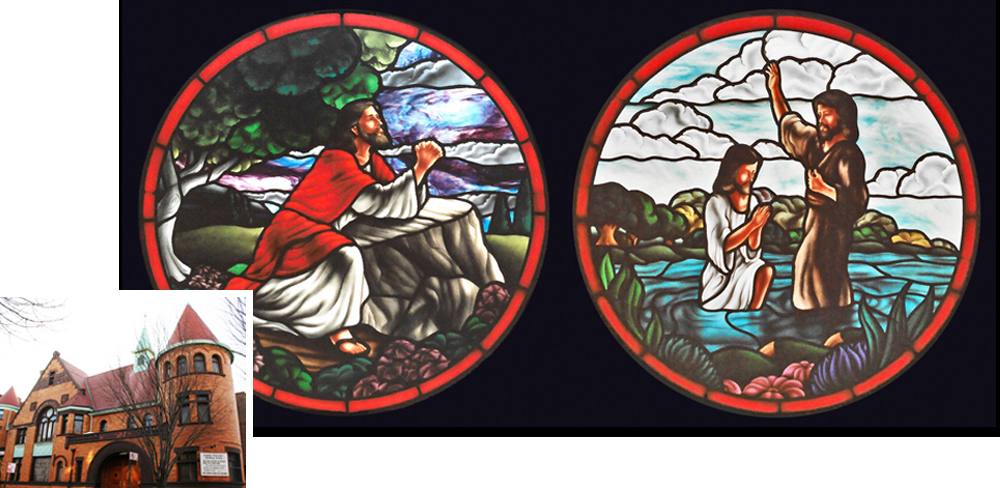
Ray Gregory, stained glass
St. Aidan's Chapel
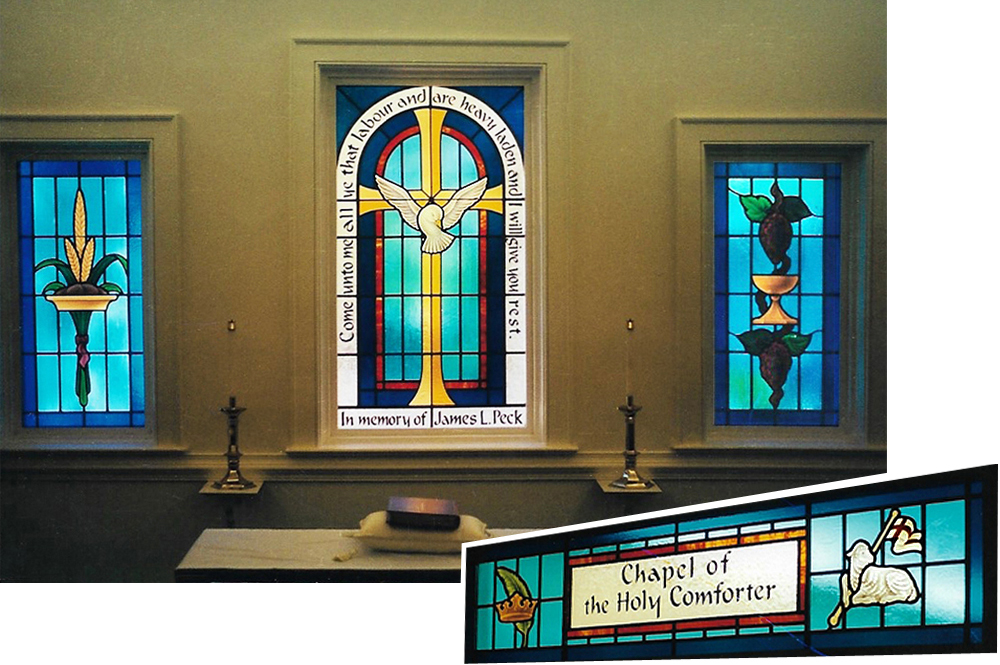
Craddock Presbyterian
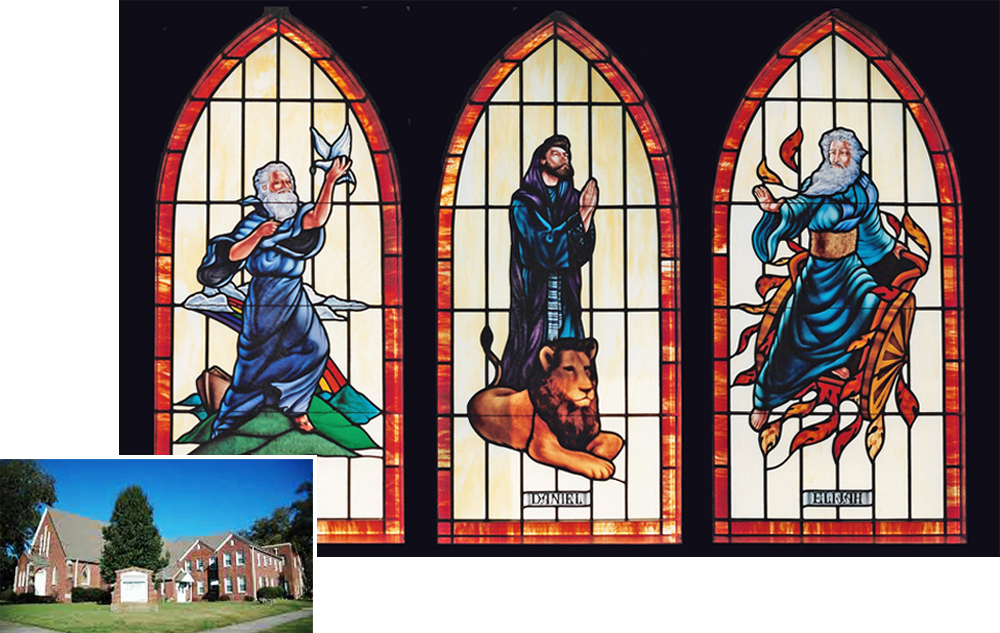
King's Grant Presbyterian
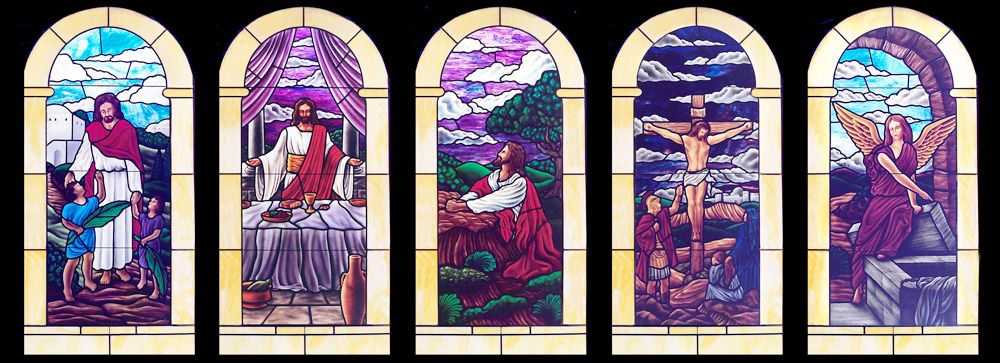
From King Grant's columbarium stained glass
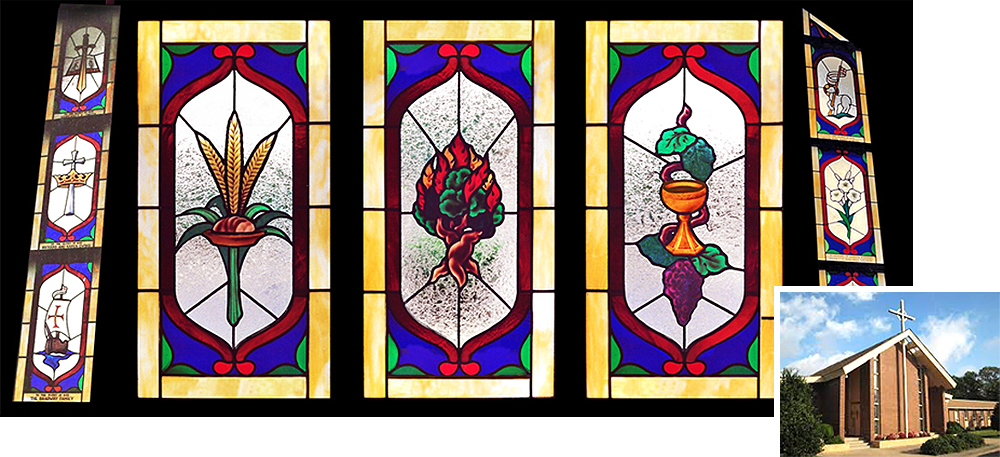
St. Bride's Episcopal
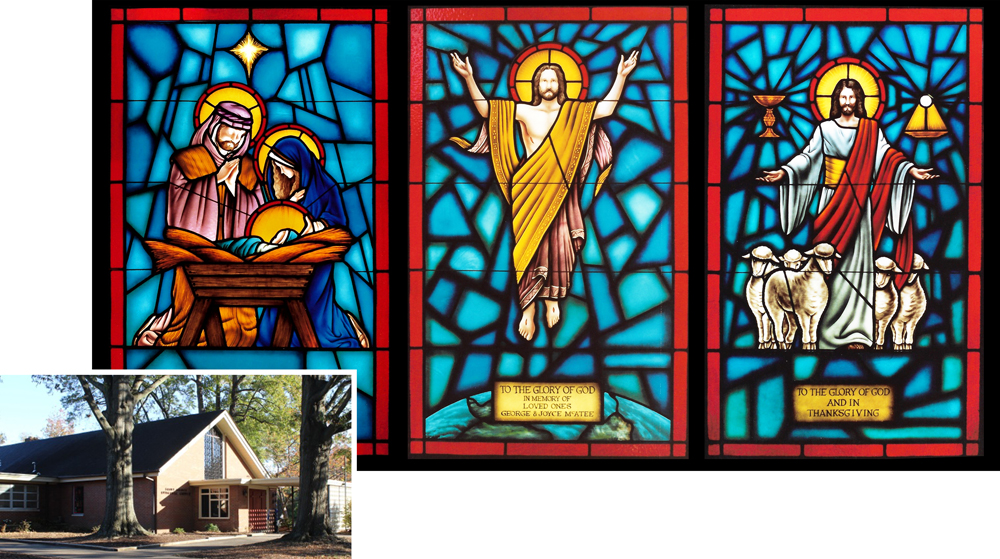
Fourth Baptist, Portsmouth
African American architect Spencer Scott, whose work I greatly admired, designed this window for Fourth Baptist Church. I think he said his father was or had been its preacher. You'd have to ask Spencer why he called for two omegas and no alpha, since I've forgotten. (The black horizontal bars in the photo are parts of the church's architecture that were between the camera and the window.)
— Ray Gregory
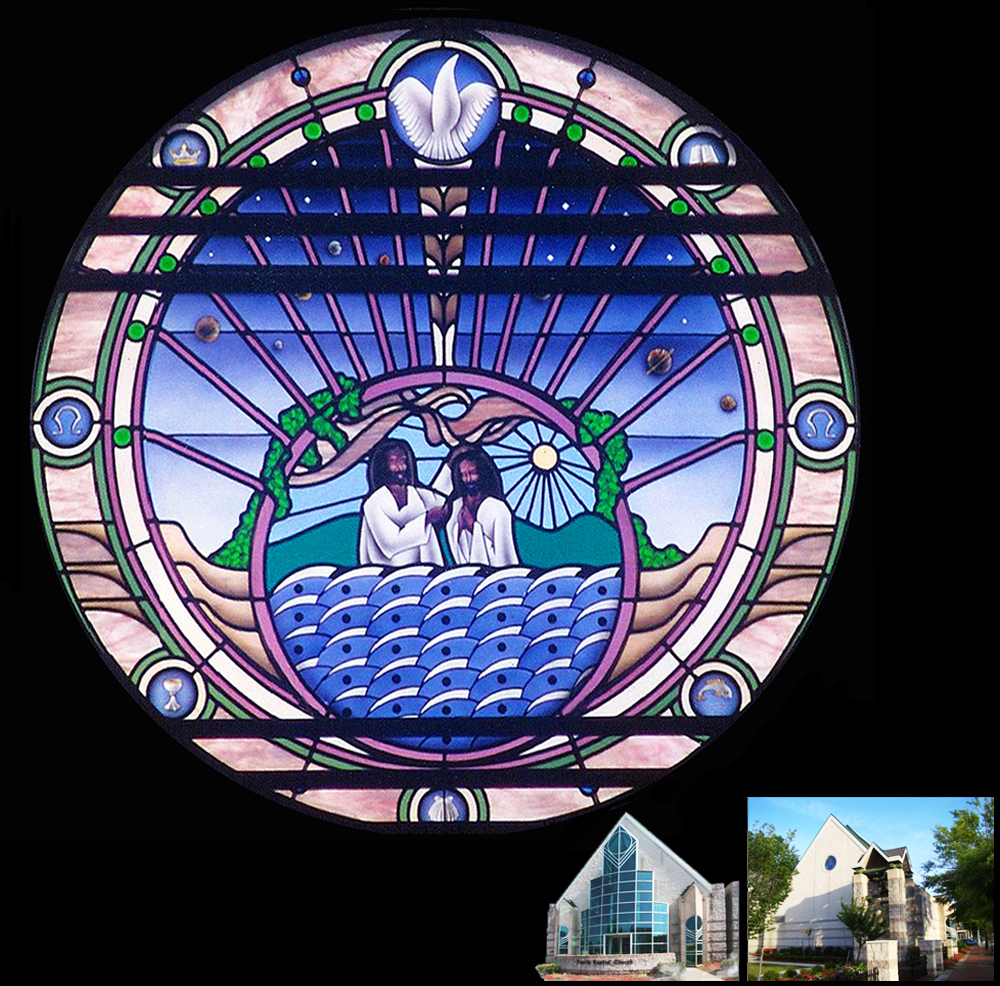
Piney Wood Chapel (Gates, North Carolina)
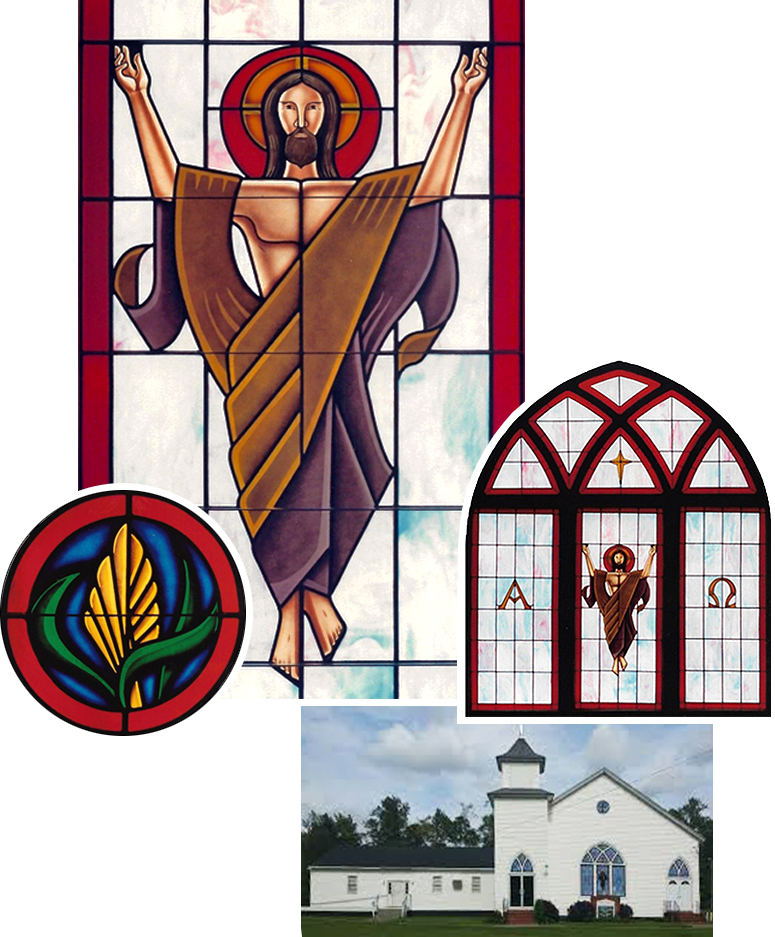
New Mount Olivet Baptist
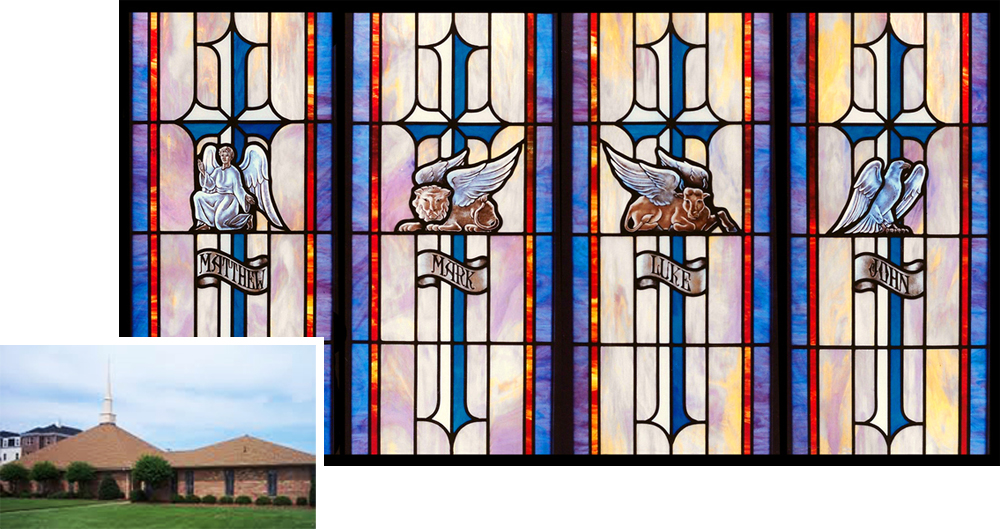
Ocean View Presbyterian
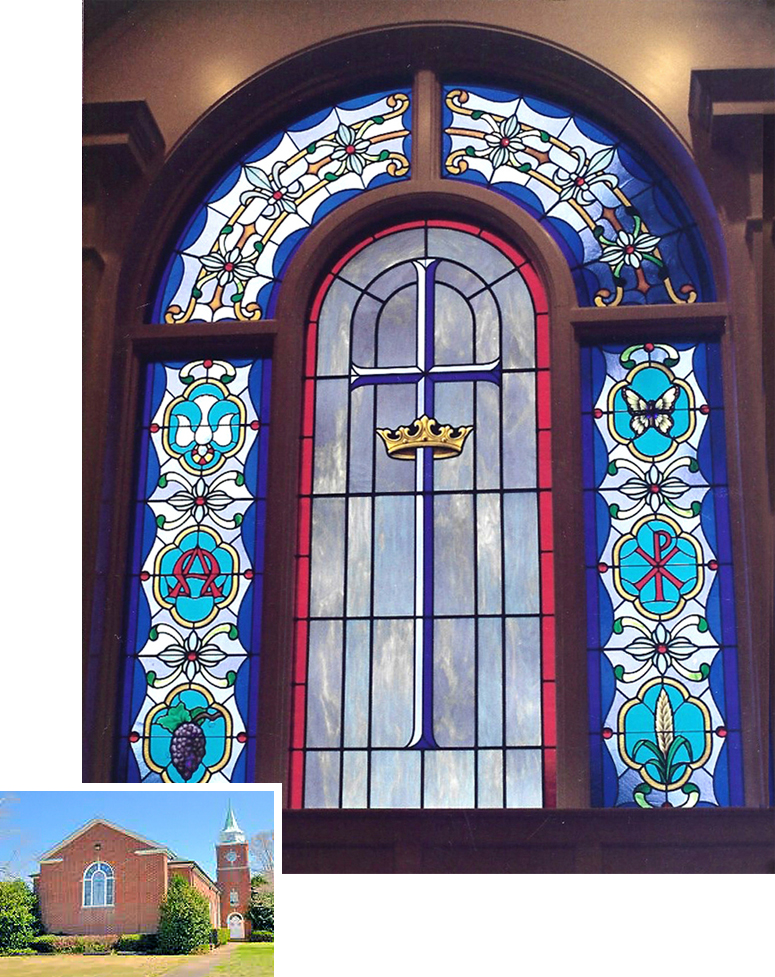
St. James United Methodist
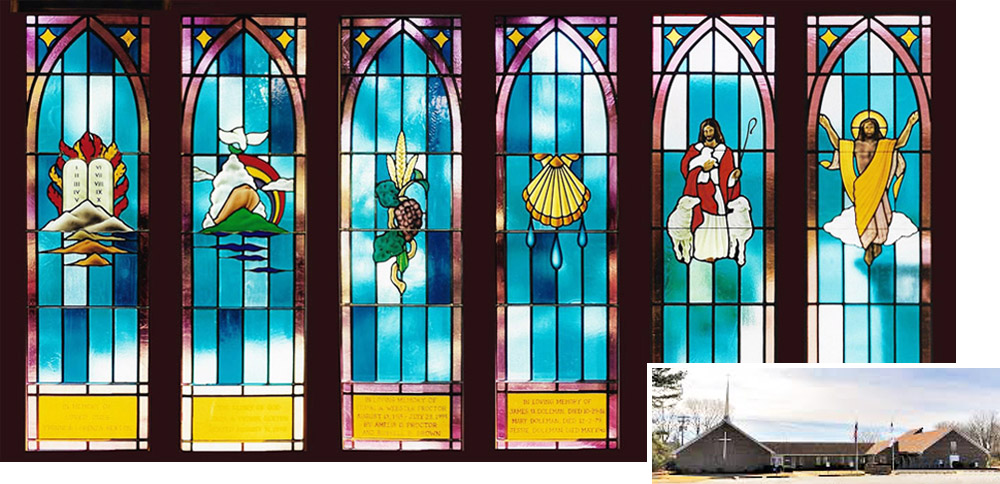
St. Mark's Chapel
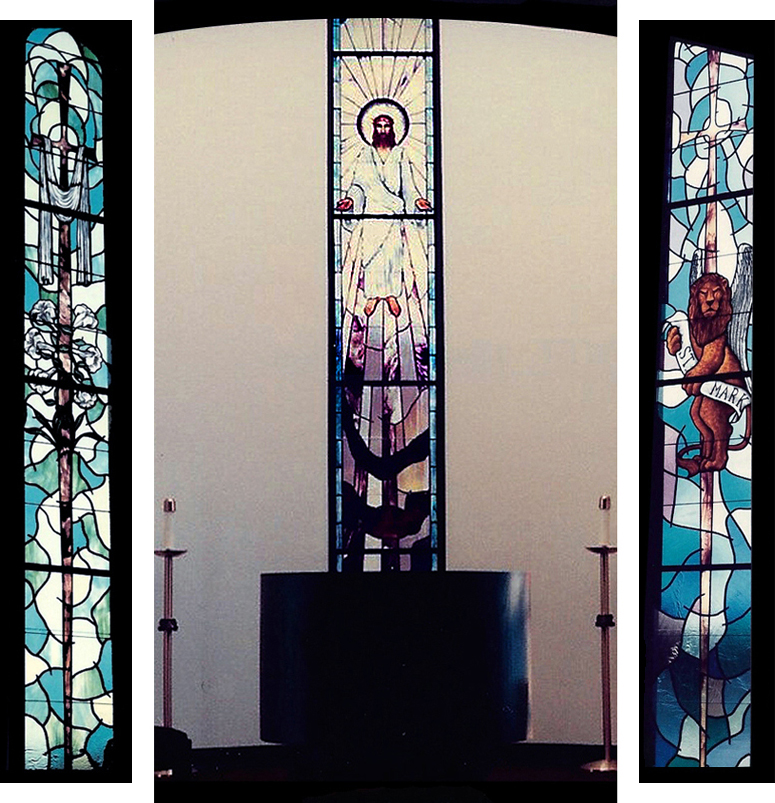
Virgin and Child stained glass panel I made for my wife who's of Greek extraction and was raised in the Greek Orthodox tradition. The design came from an old Orthodox icon, but I tweeked some of the details, including making the child a little more childlike (plumper and proportionately larger head), instead of the typical homunculus (small adult) look found in the old icons.
— Ray Gregory
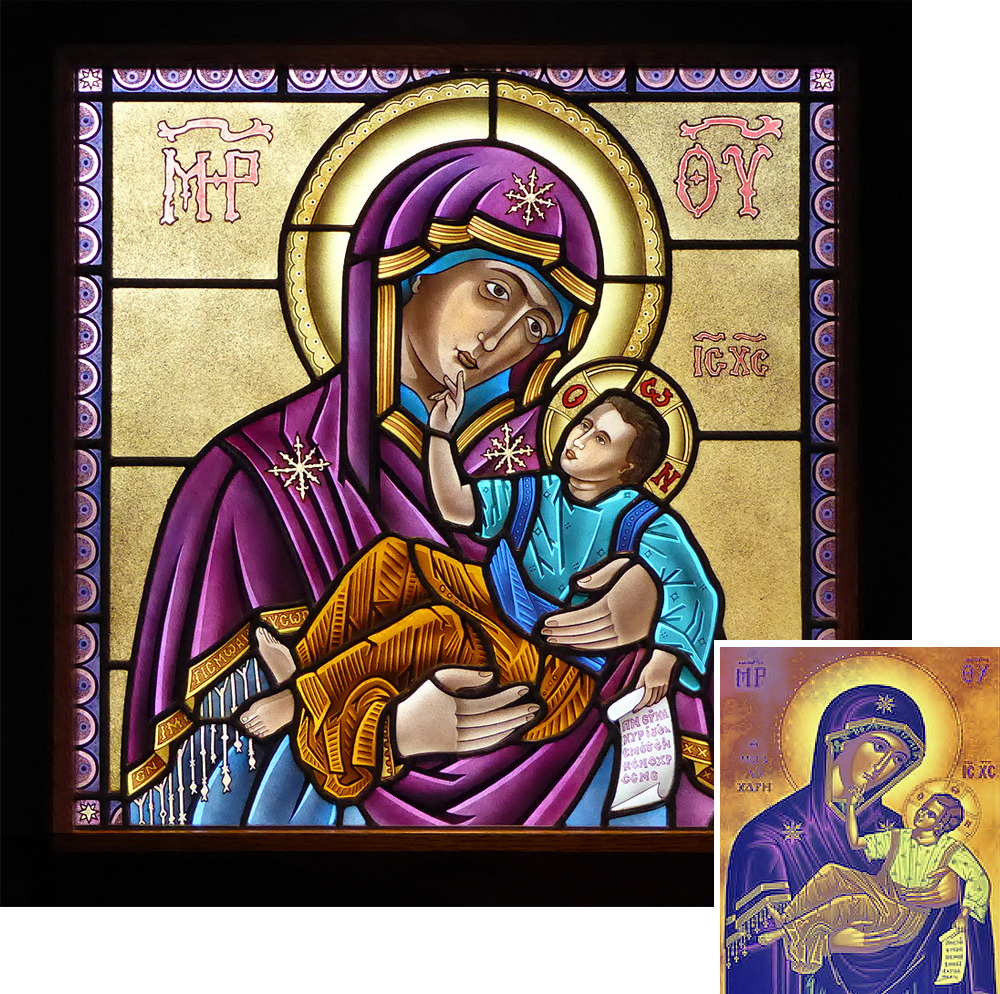
Stained glass school seal donated to Norfolk Collegiate School
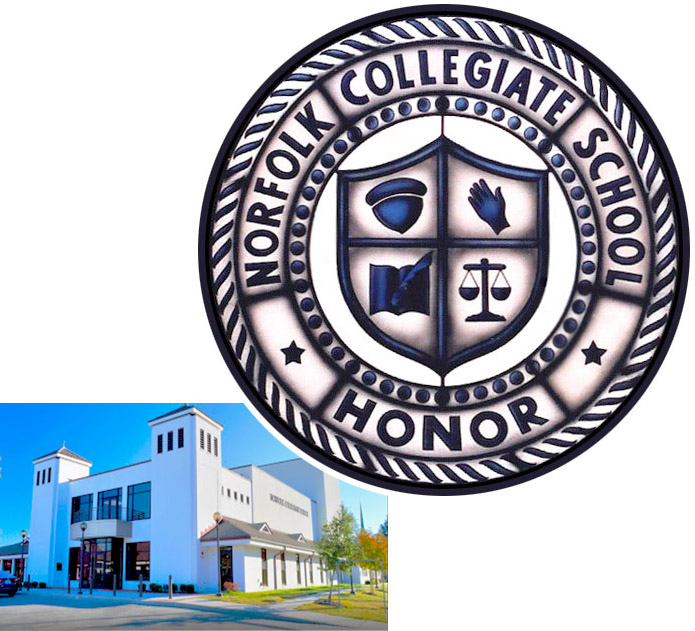
Restaurants
With apologies to an old god, a 17-feet-tall window for Capt. George's restaurant in Pungo
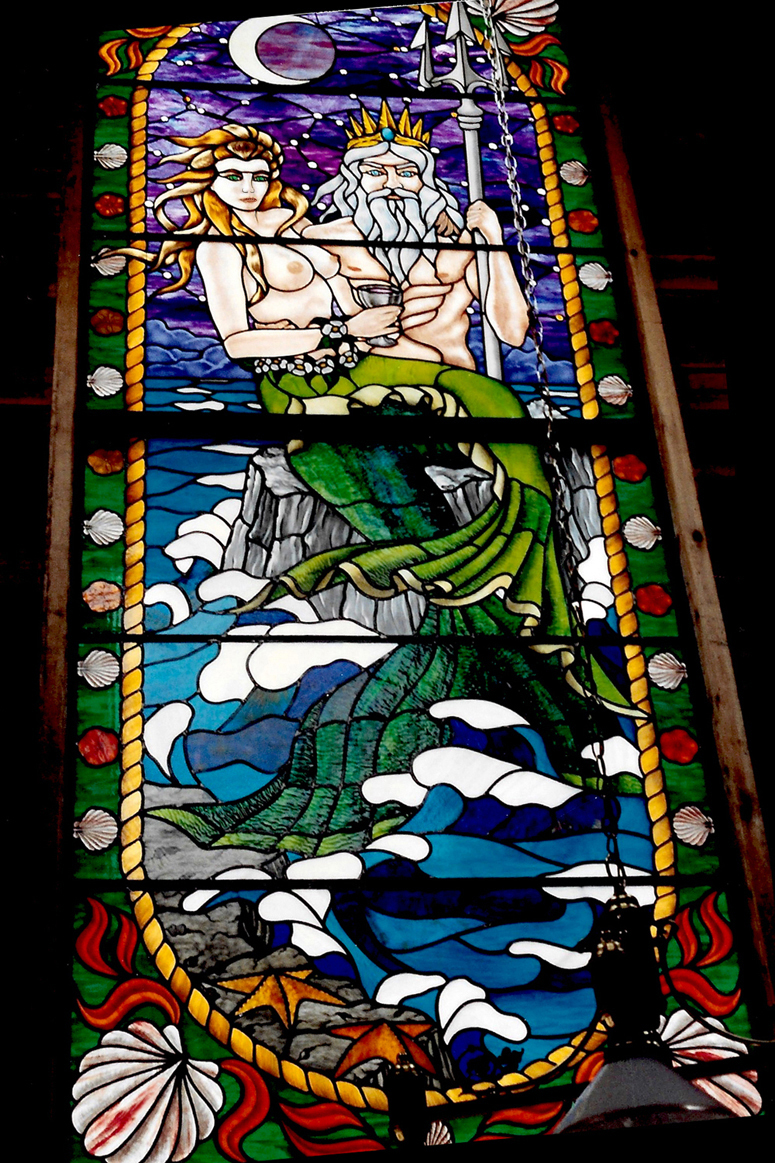
Funny story: Jack Macione of Forth Dimension Design and Decor called to tell me they wanted stained glass for the large tower window at Capt. George's new restaurant in Pungo (in the nether regions of Virginia Beach), which was soon to open. Jack said he wanted to see Neptune with a mermaid on his lap, and he added he wanted the mermaid to have "big bare breasts." Typical Jack. Okay then... So when I took him a design sketch, which conformed to all his specifications, the old salt readily approved it. But once the brazen stained glass scene was installed, Jack called me back. The restaurant had gotten complaints from some of its customers, he said. He asked what it would cost to "put a bra on the mermaid." Seriously? I thought, since the big stained glass domes we'd already made for Capt. George's had topless mermaids too. I explained to Jack that stained glass bras didnt come that cheap, since we would have to set up the scaffolding again and take down all three panels of the upper half of the window just to get to the offending anatomical parts. And after that, I heard no more about the problem. Who, I had to wonder, goes to a Capt. George's and worries about a topless mermaid overhead, when there's all that sumptuous food to ogle and drool over at the buffet? After the Pungo restaurant closed, I heard that the Neptune-and-mermaid glass had been moved down to Capt. George's in Myrtle Beach. Maybe the customers down there weren't so prudish.
— Ray Gregory
Capt. George's Domes
In the main dining areas of Capt. George's Seafood Restaurant on Laskin Road in Virginia Beach, two 34-feet diameter domes (the "sky" and "map" designs started with a couple of dinner plate-size sketches)
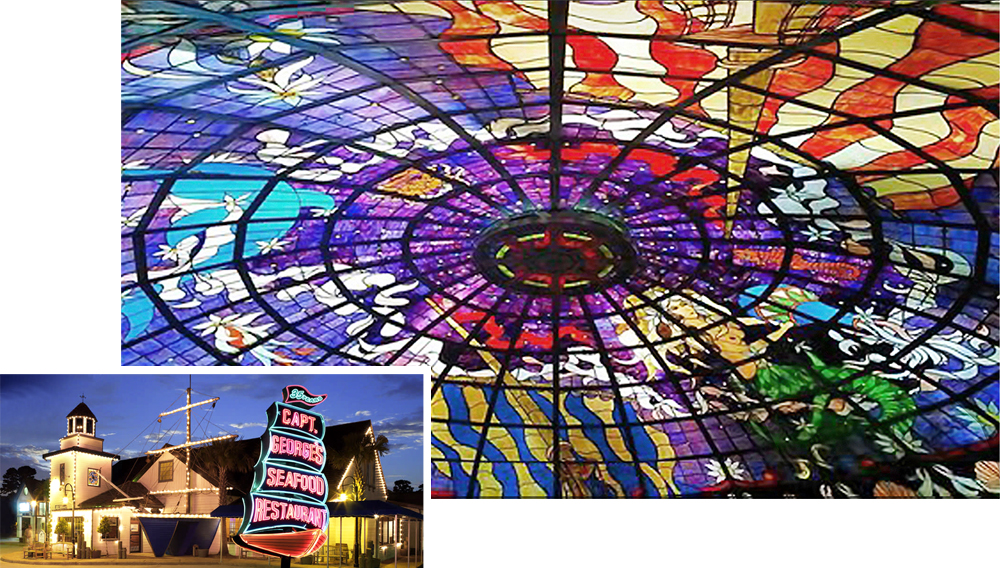
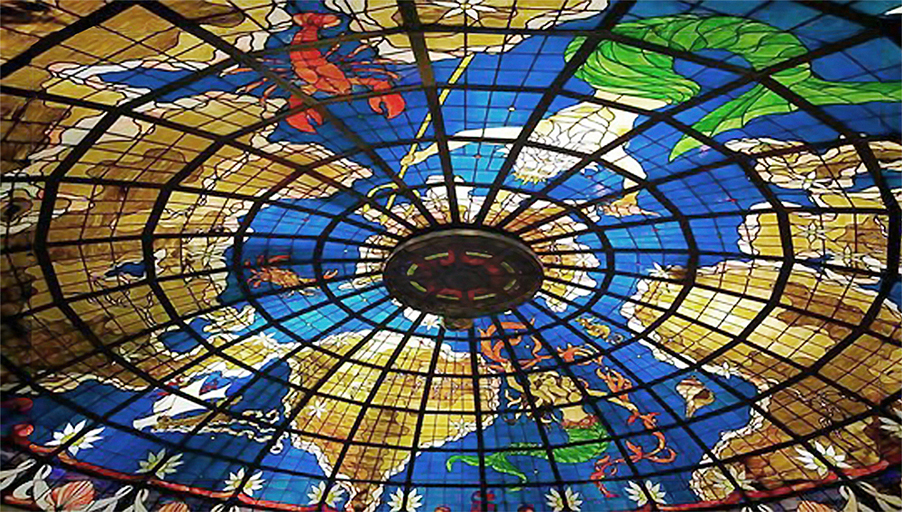
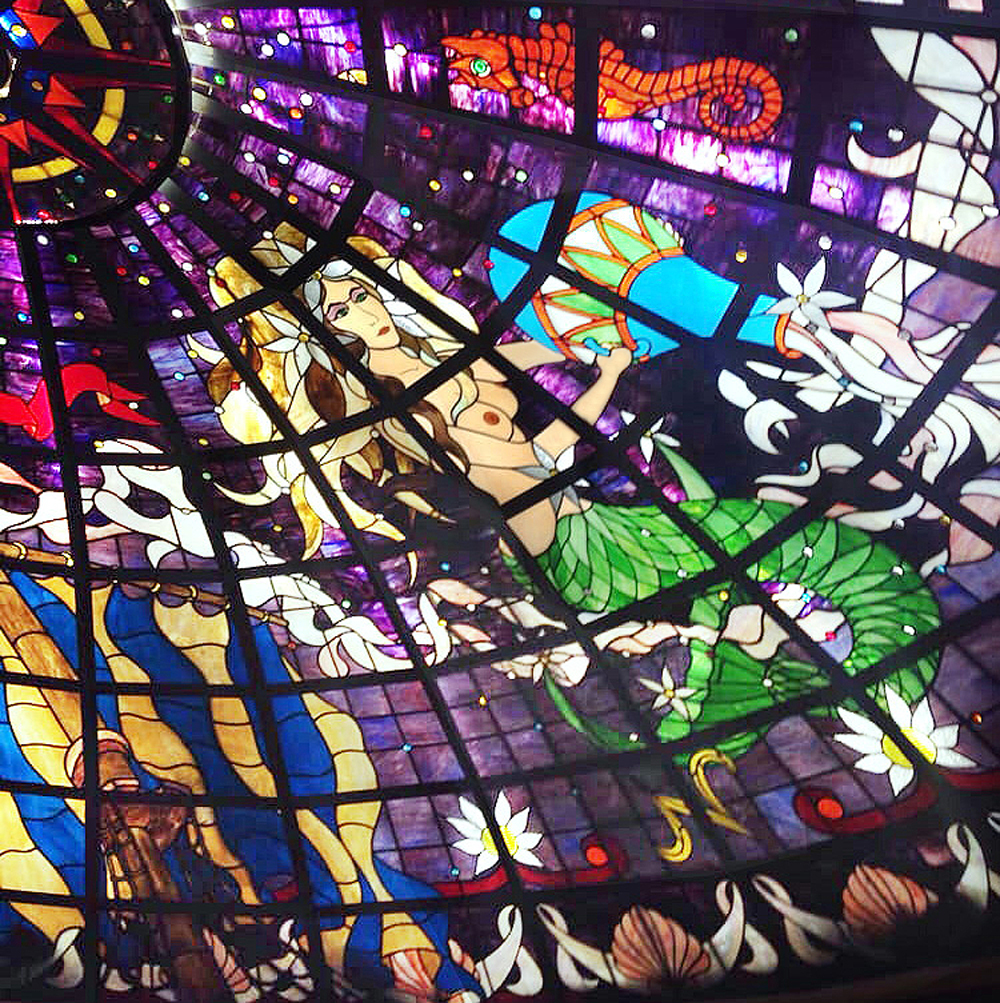
Lots more for Capt. George's
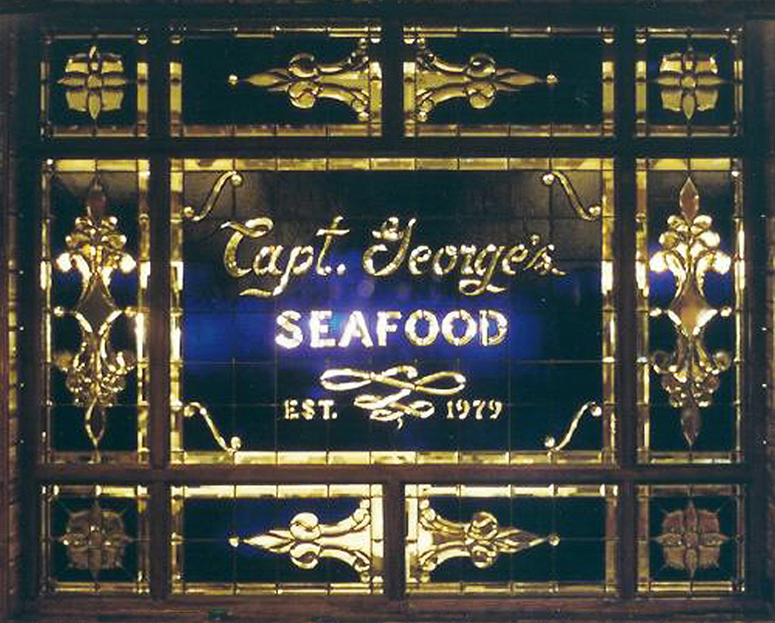

A sweets shop that used to be in Ghent
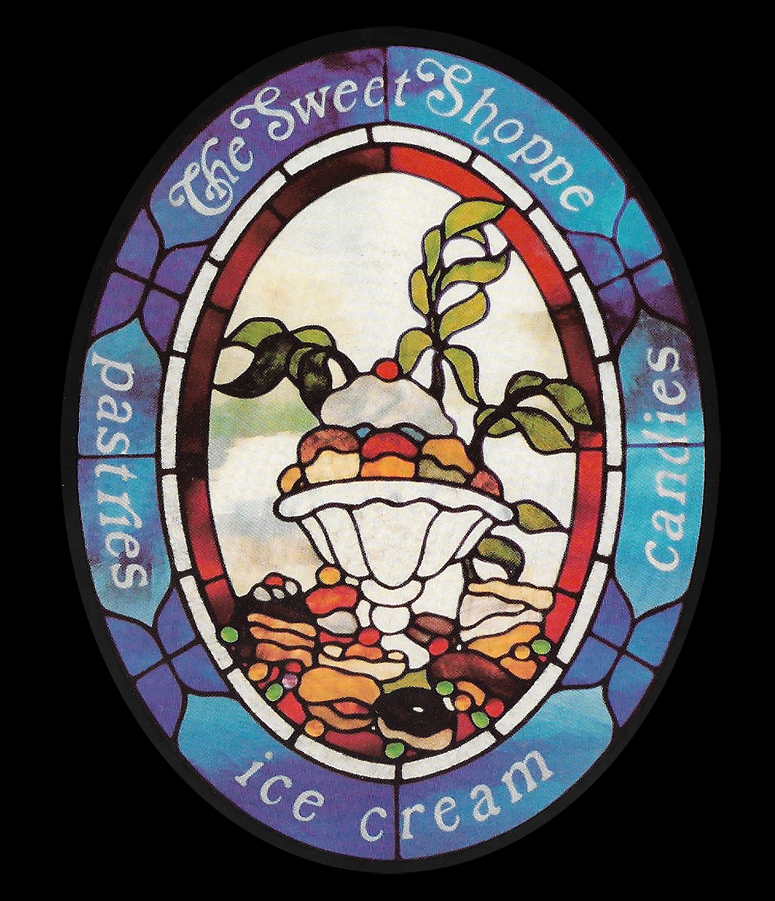
Basement lounge, the Madison Hotel
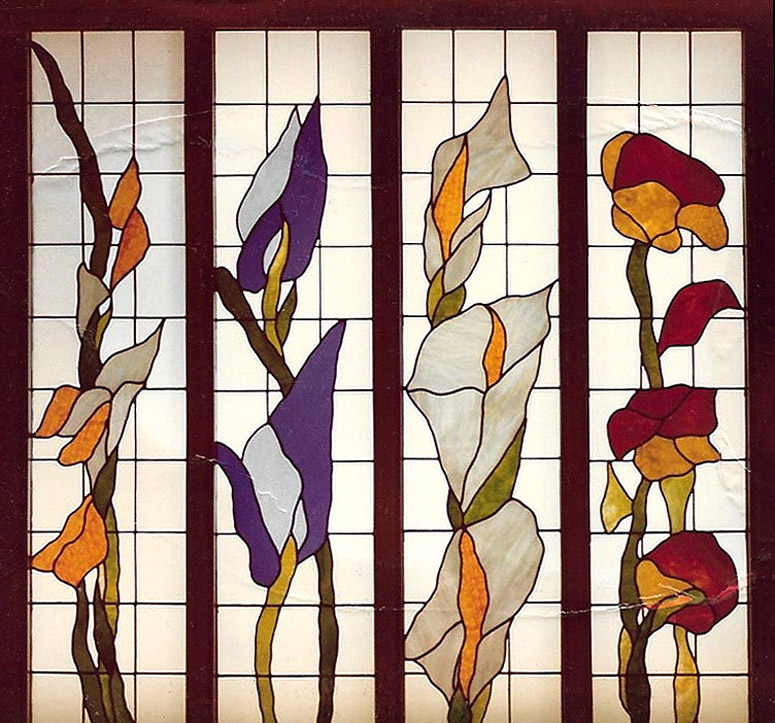
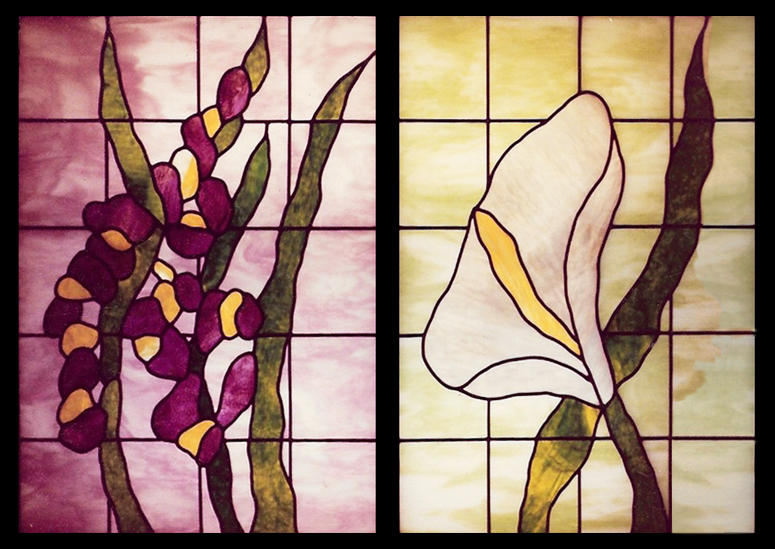
A pool room at the Norfolk Naval Shipyard
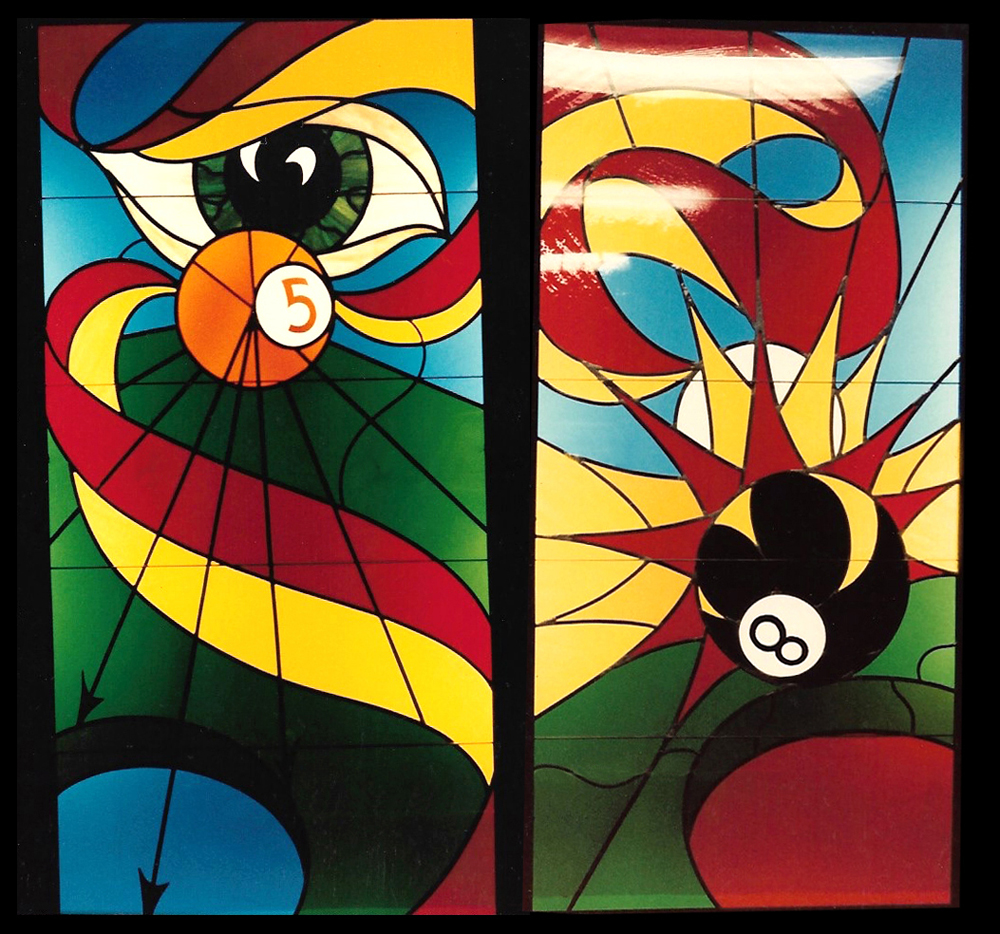
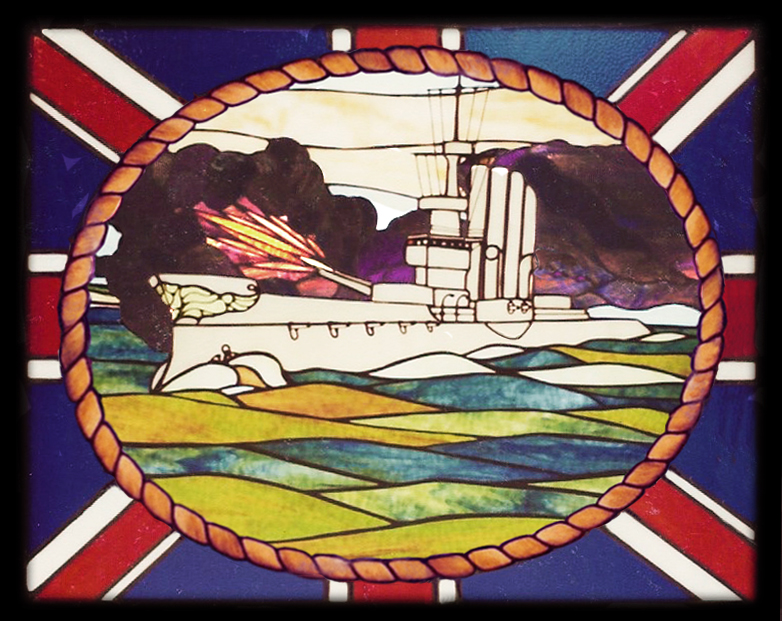
Sci-Fi Glass 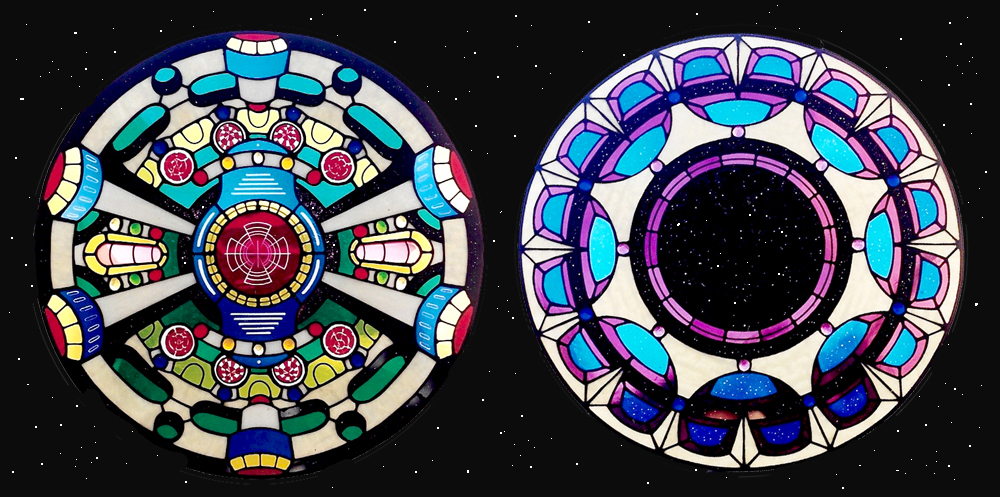

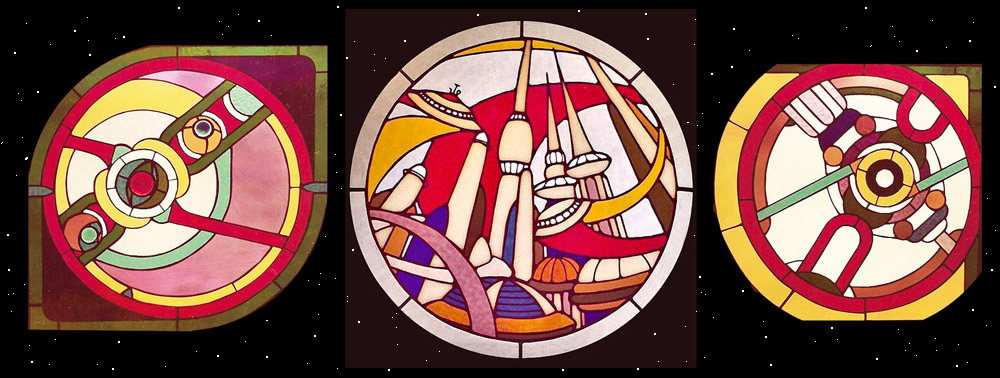
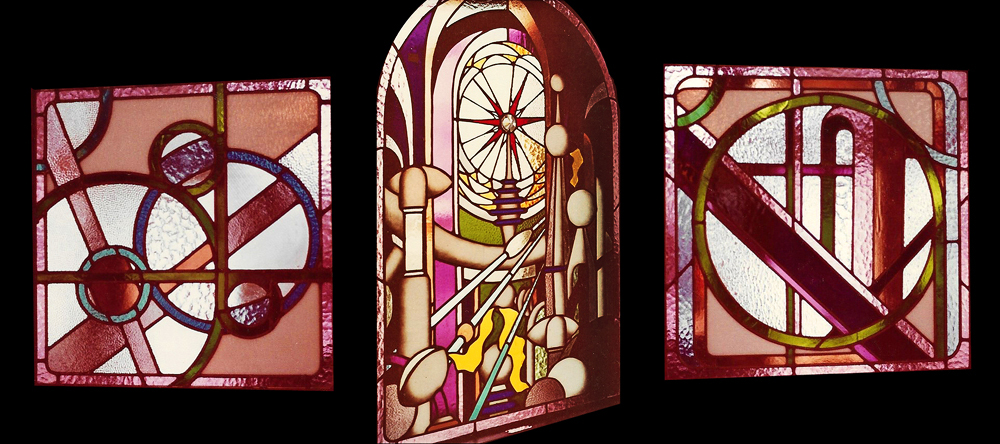
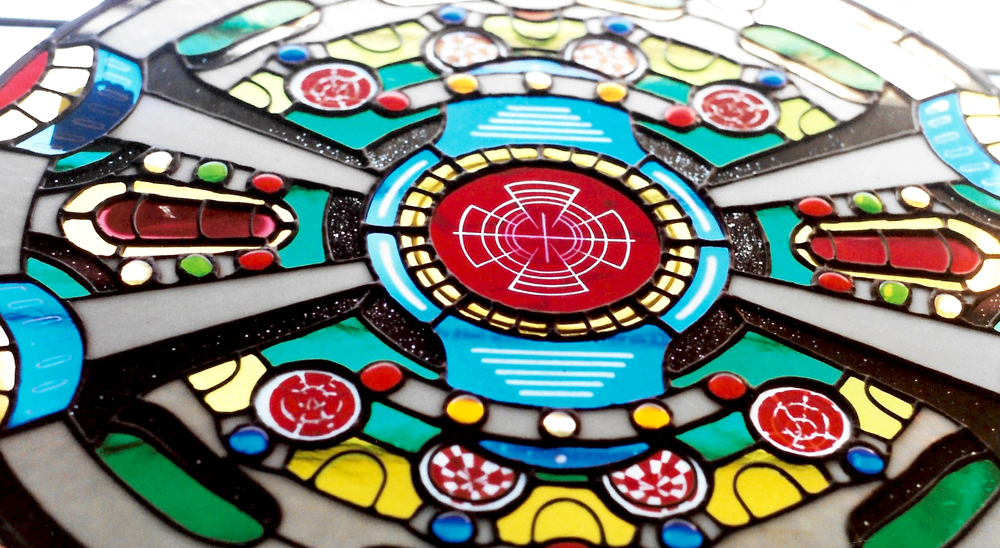
Residential Work
One of Art Glass' first residential jobs was stained glass for the kitchen windows of the delightfully cluttered Victorian mansion of John and Rose Parker in the Ghent neighborhood of Norfolk.
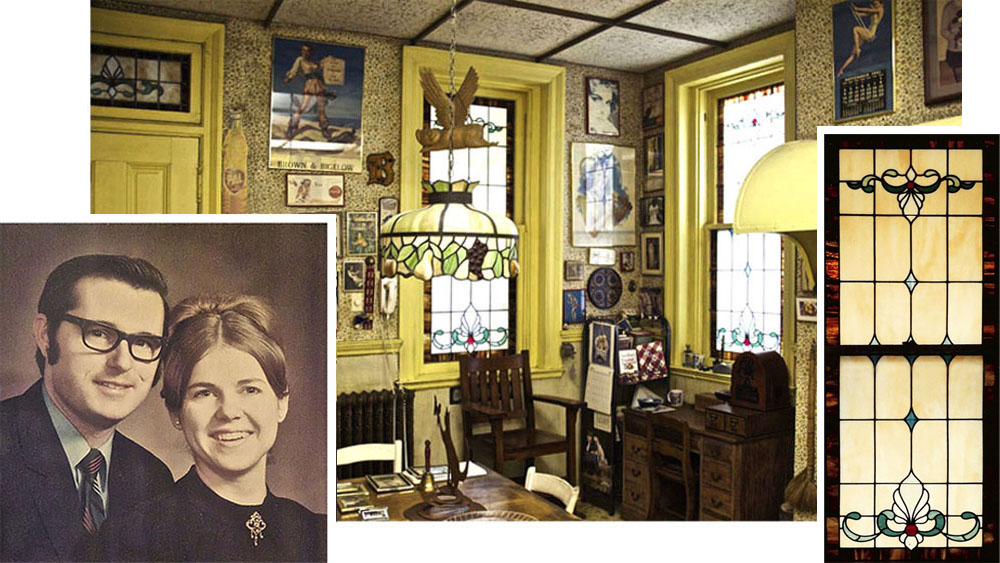
Stained glass, Ray Gregory, Art Glass Resplendent, Norfolk
Something for a more contemporary Ghent residence
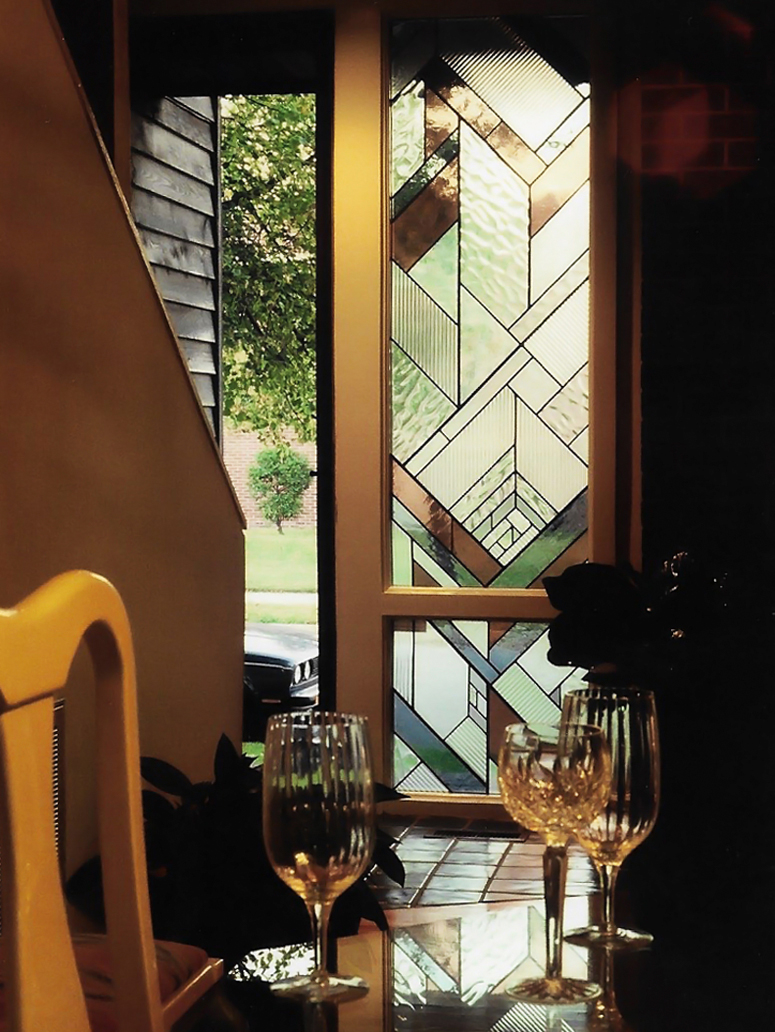
Stained glass, Ray Gregory, Art Glass Resplendent, Norfolk
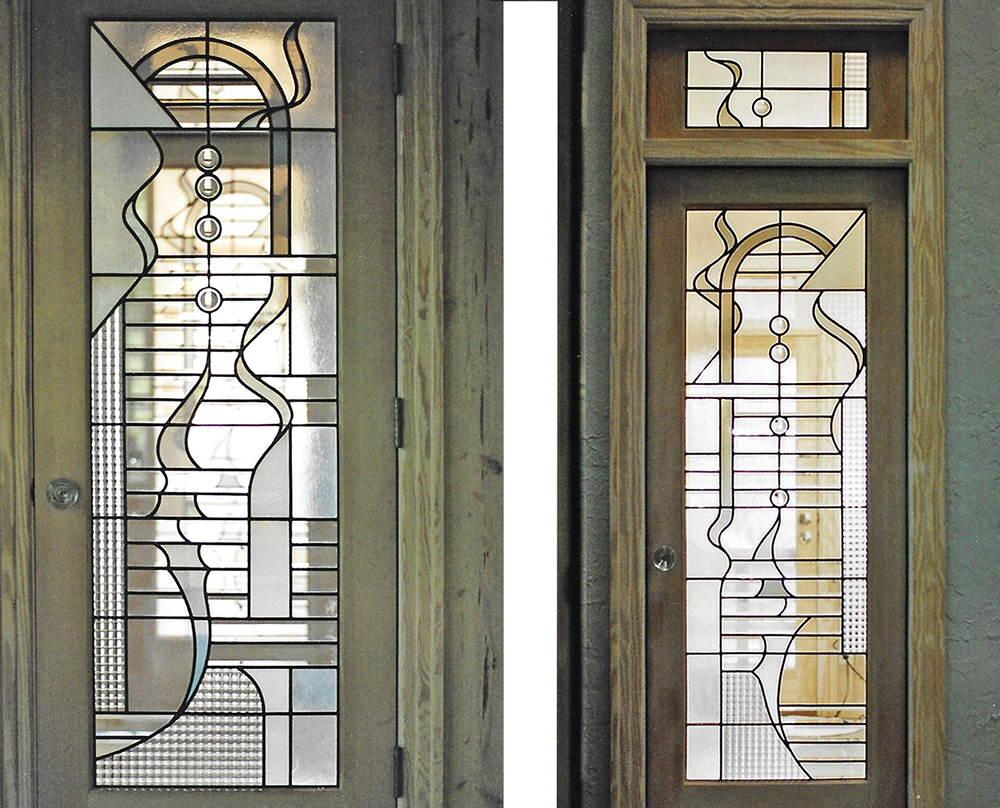
This one was modeled after a Persian rug, for an interior designers' show that was staged in the Victorian-era Hunter House in the Freemason neighborhood of Norfolk in the early 1980s. Years later it lives in the Palladian window of a retro house, though with a more modern interior.
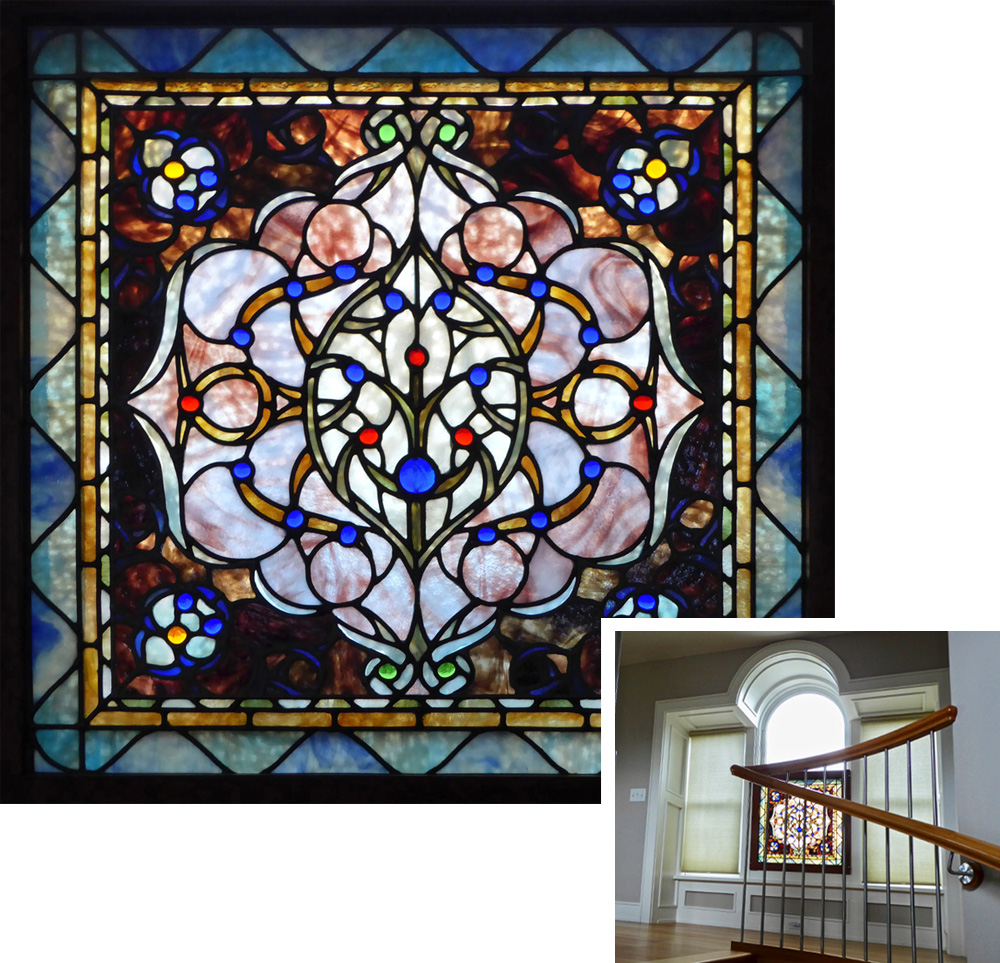
Cabinet door lights made to match the wall paper pattern
(these went to a home in Boston)
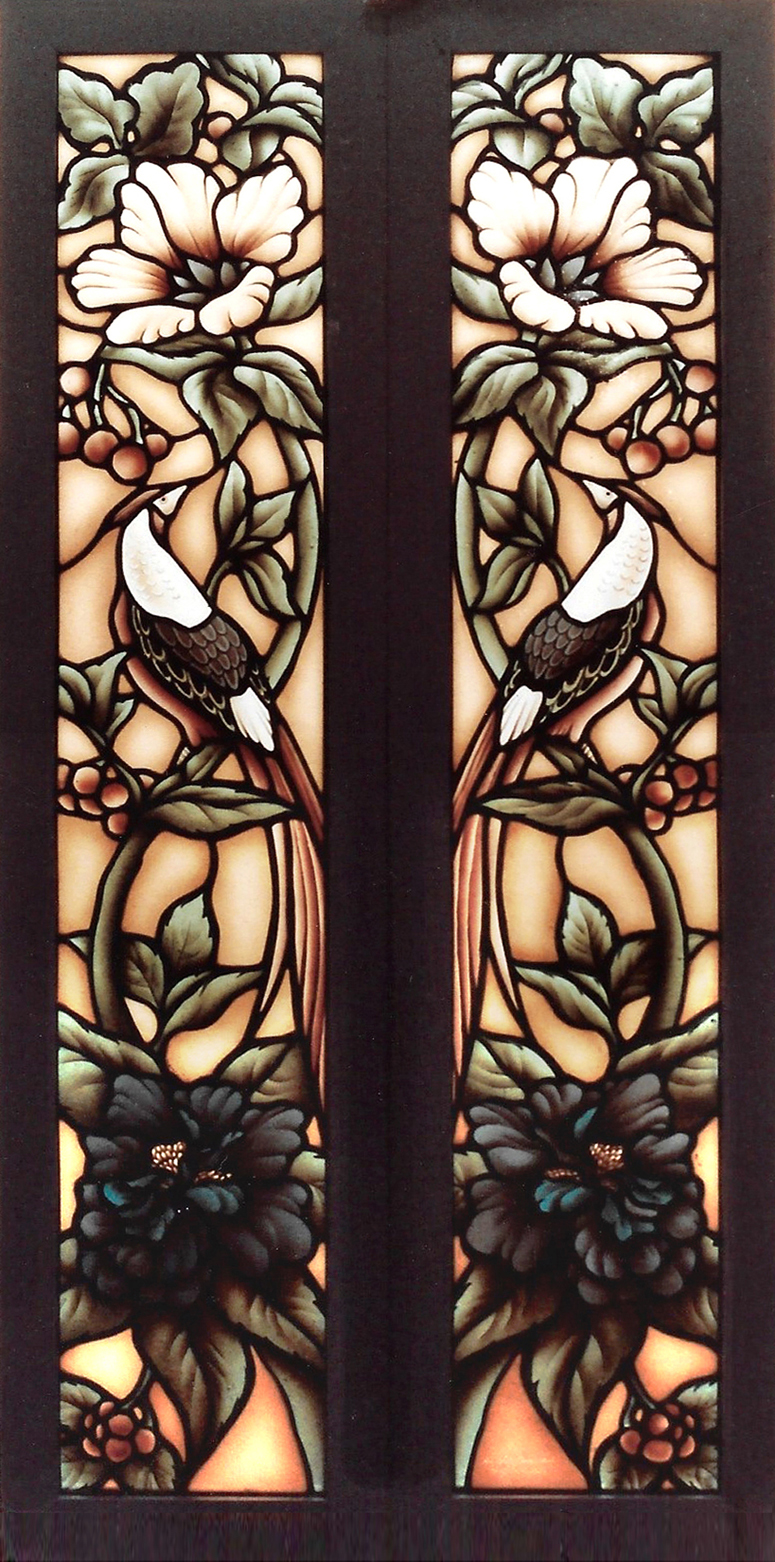
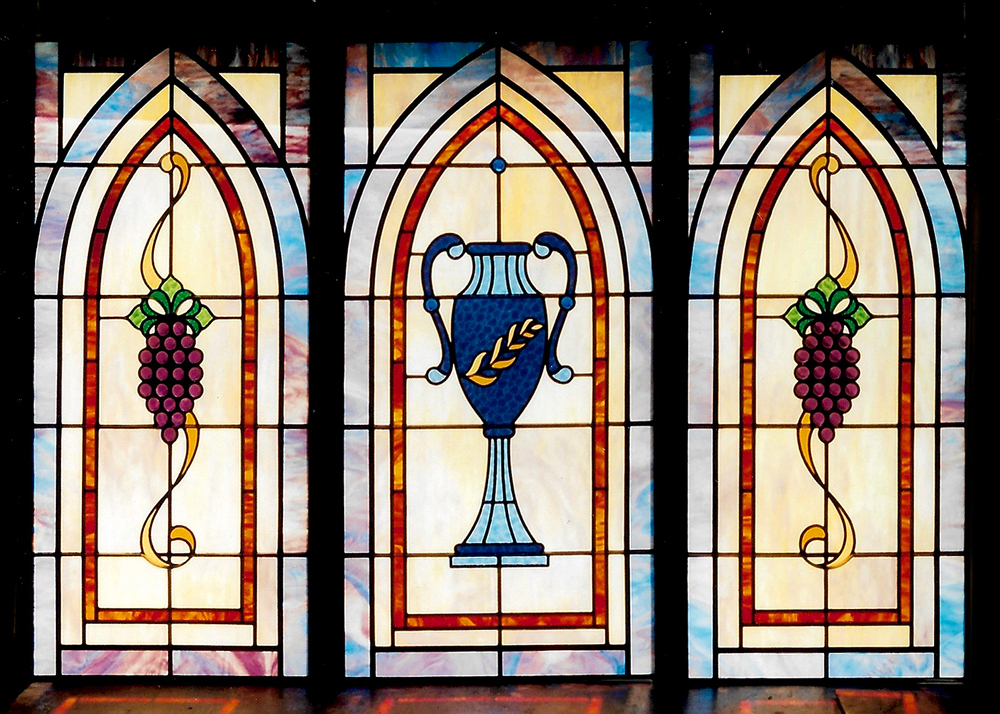
Stained glass, Ray Gregory, Art Glass Resplendent, Norfolk

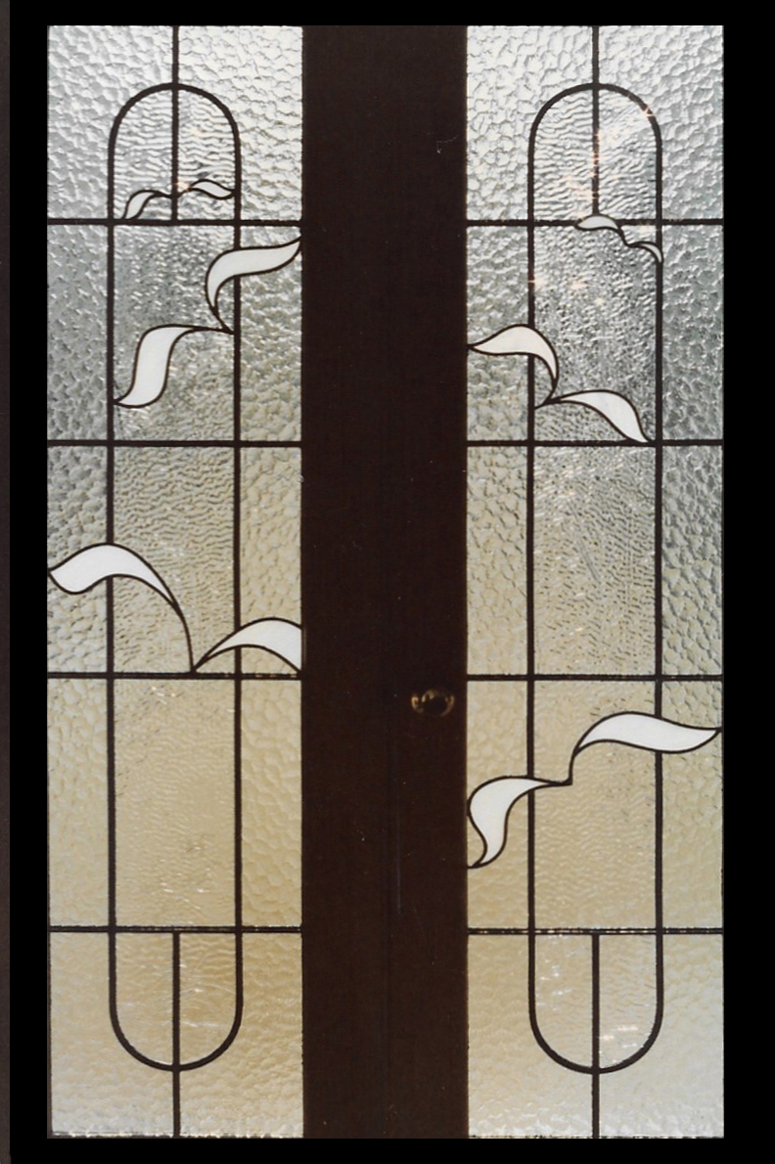
Stained glass, Ray Gregory, Art Glass Resplendent, Norfolk
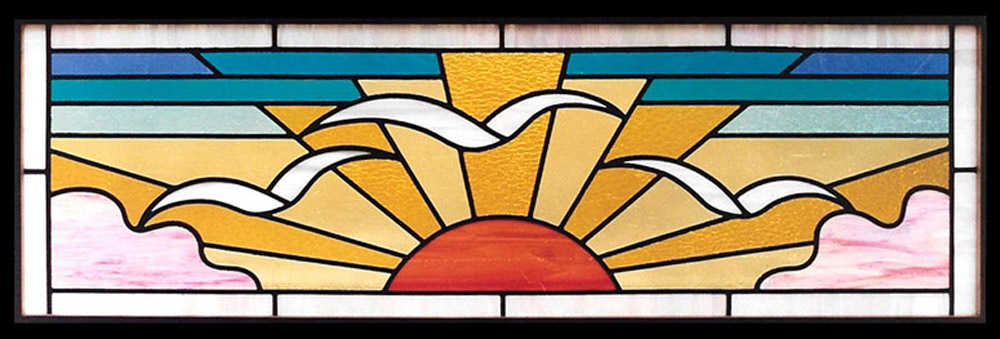
Stained glass, Ray Gregory, Art Glass Resplendent, Norfolk
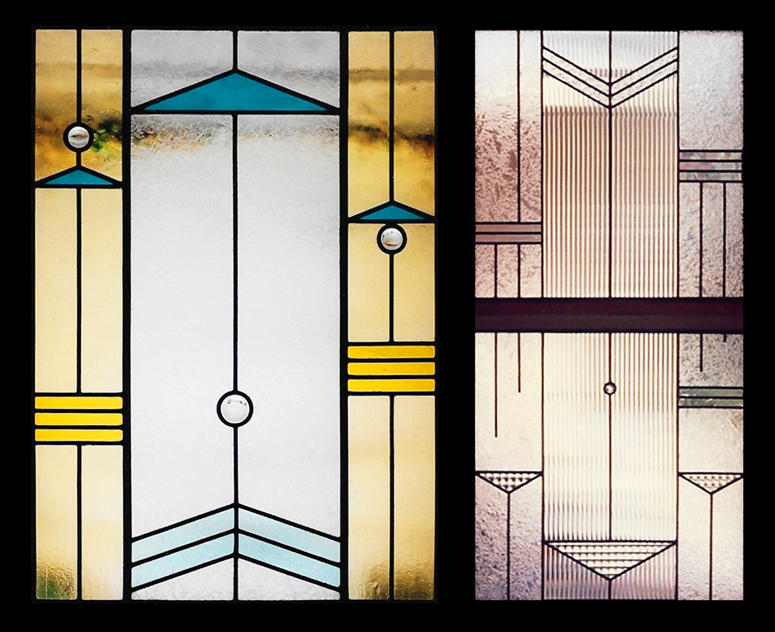
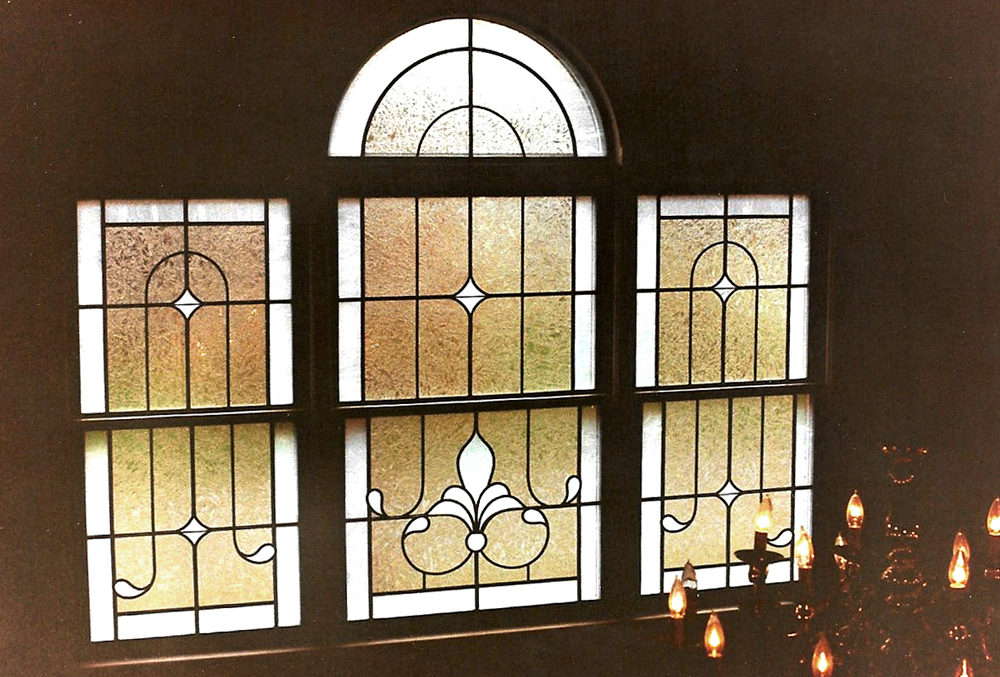

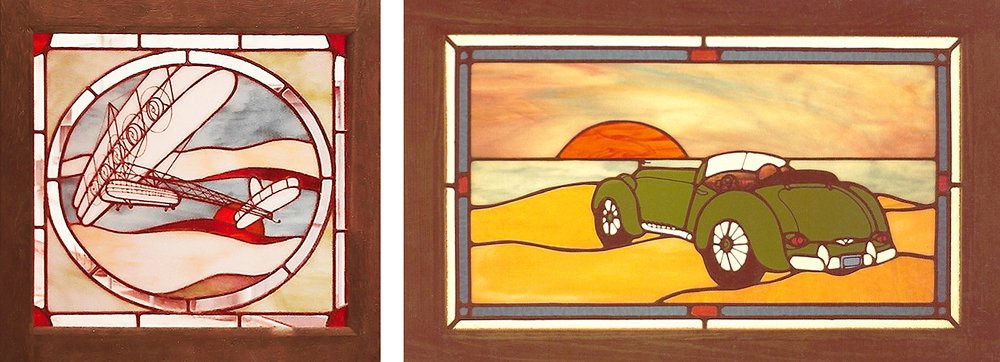
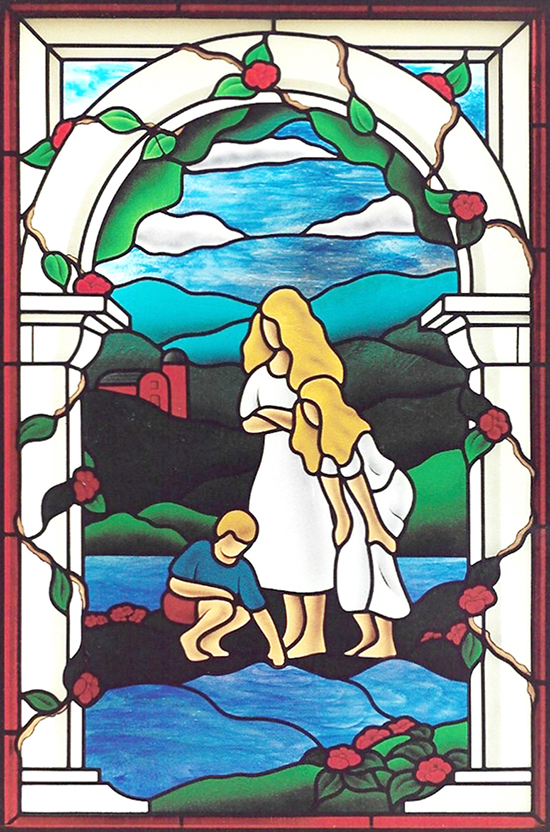
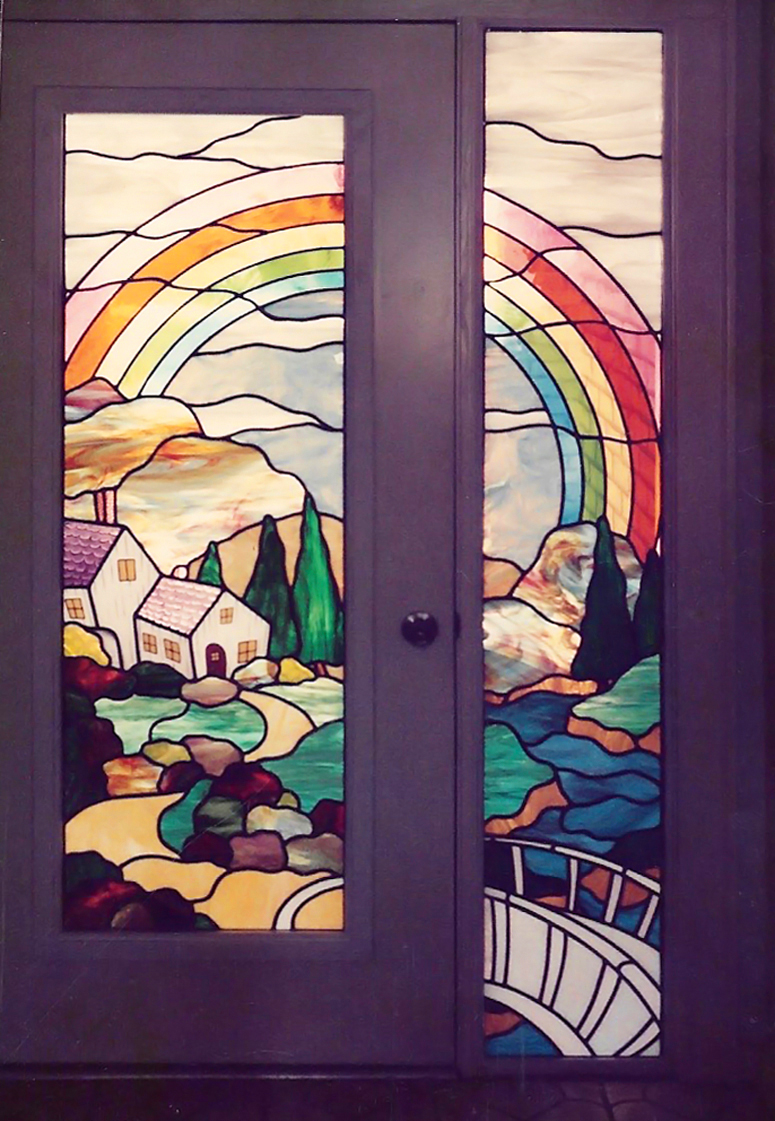
Stained glass, Ray Gregory, Art G
lass Resplendent, Norfolk
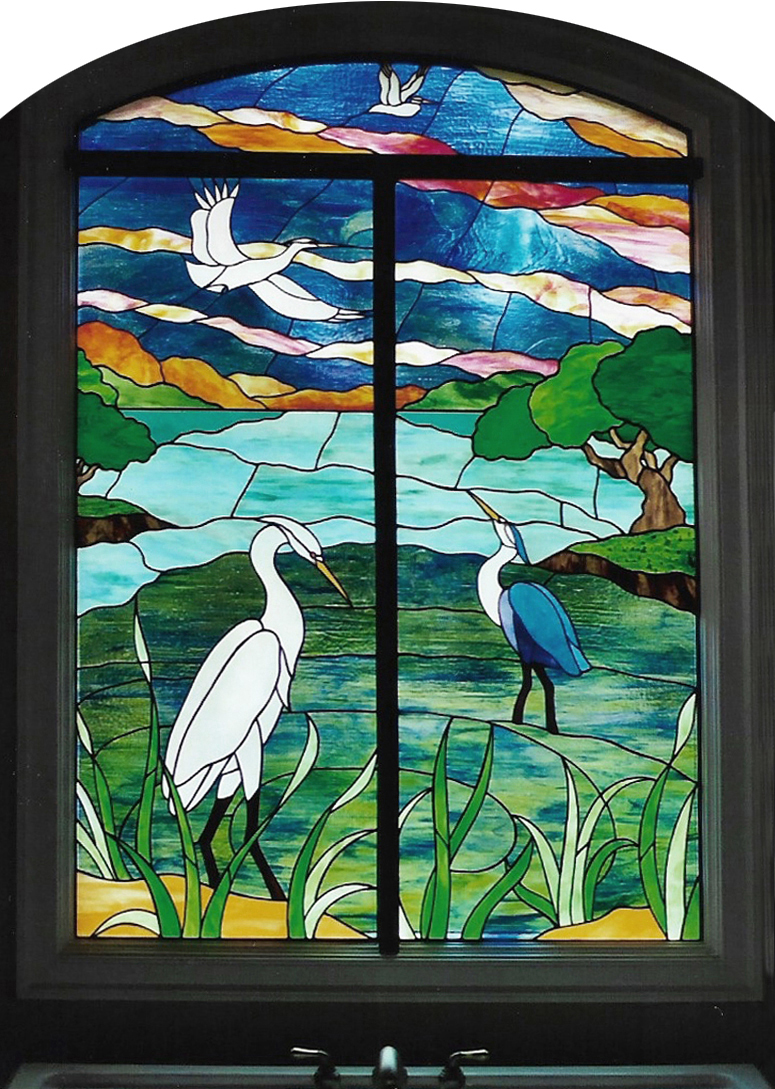
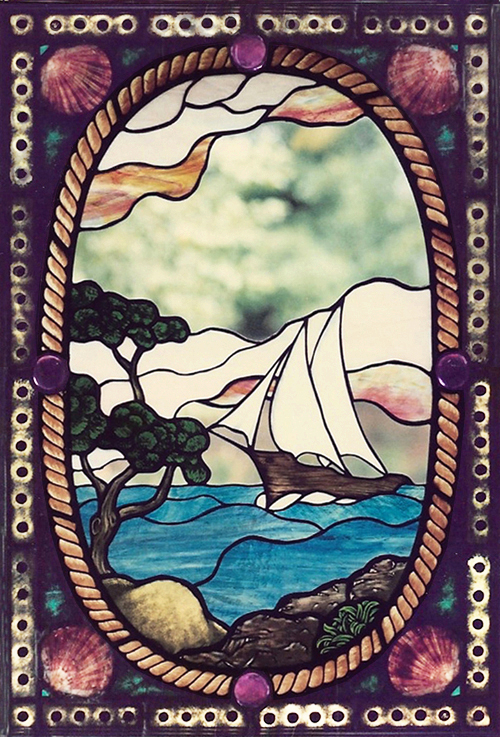
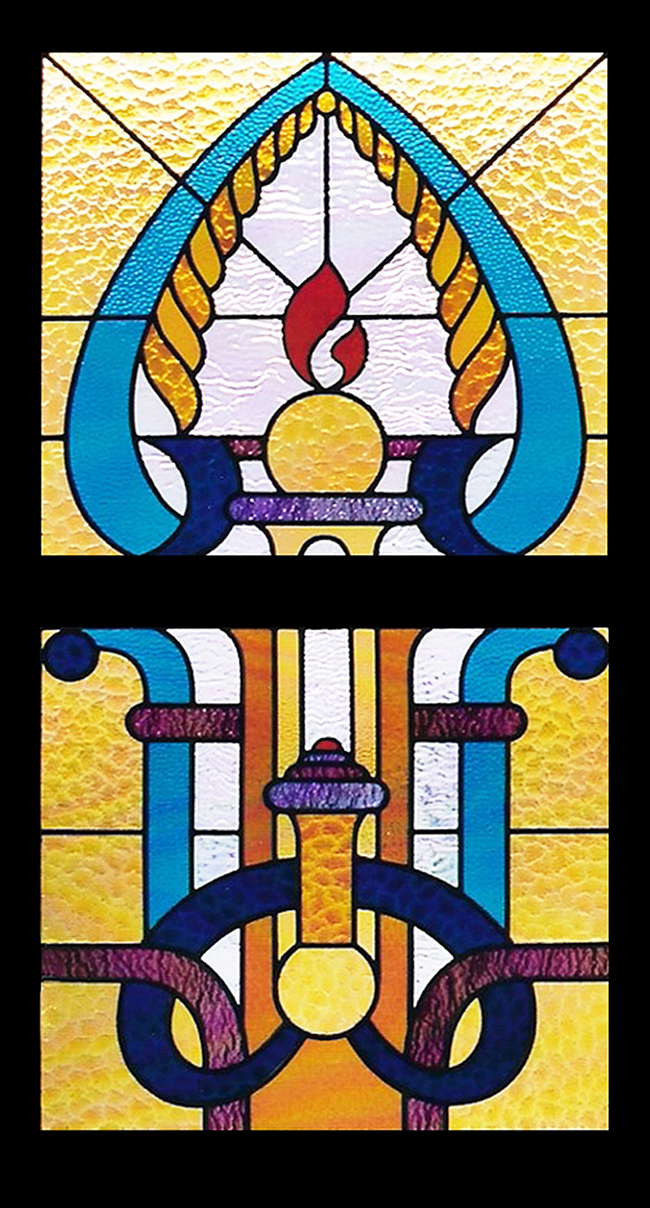
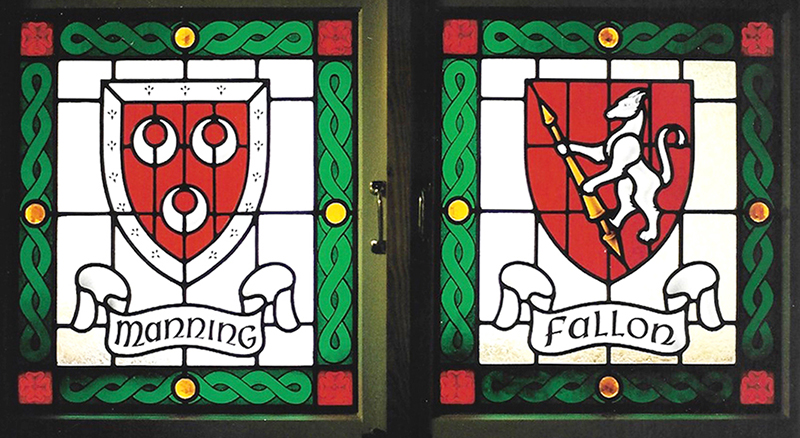
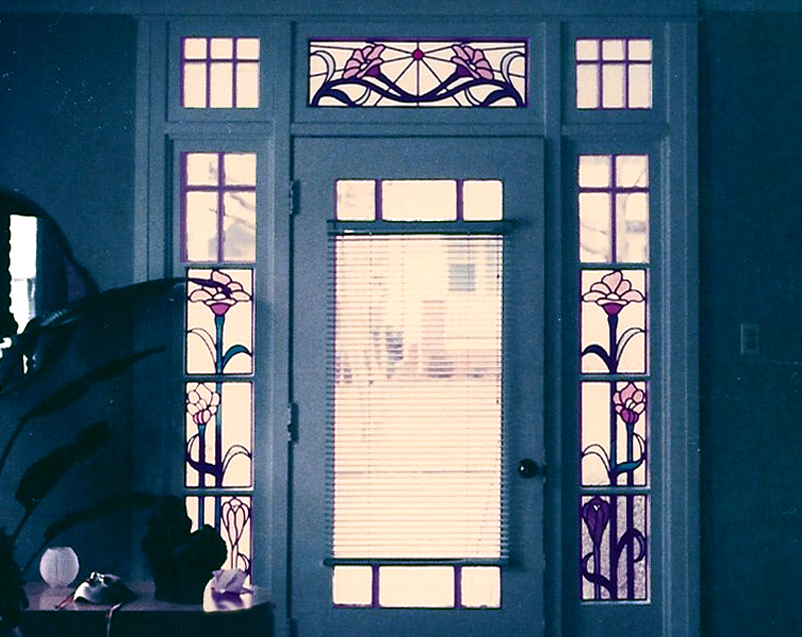
An address transom

Fireplace screen
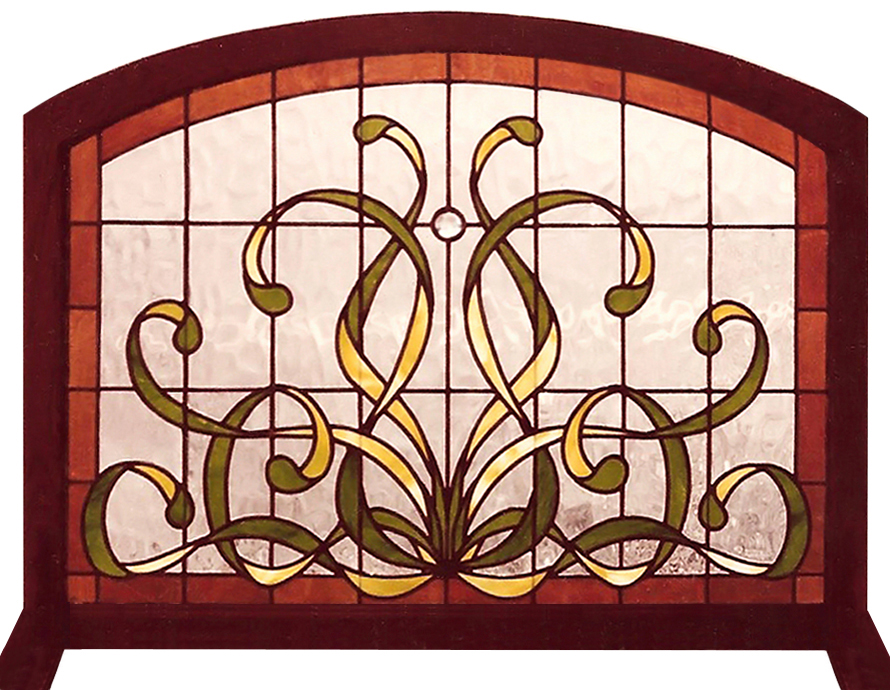
While 99% or more of the windows were made with lead came, occasionally a piece was made with the copper foil technique (traditionally used to make stained glass lampshades)
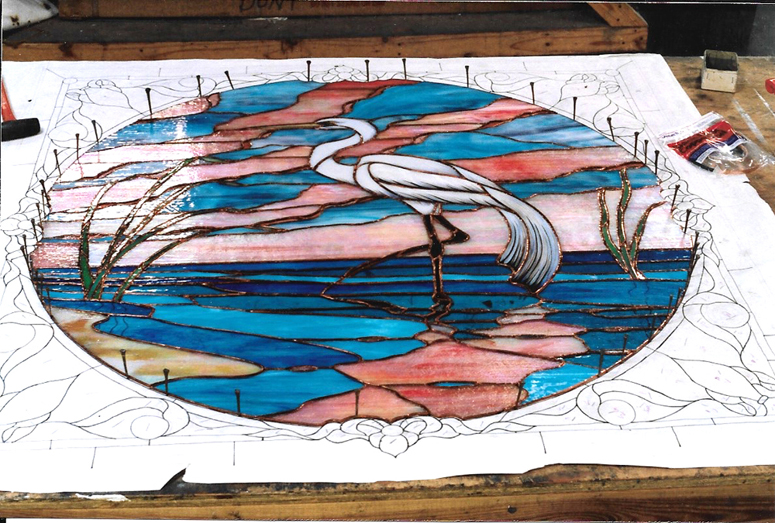
Stained glass, Ray Gregory, Art Glass Resplendent, Norfolk
Art Glass, Inc. also made and installed the handsome oak lightbox for this large copper foil work for a beach house in Virginia Beach (with a depiction of the house in the glass)
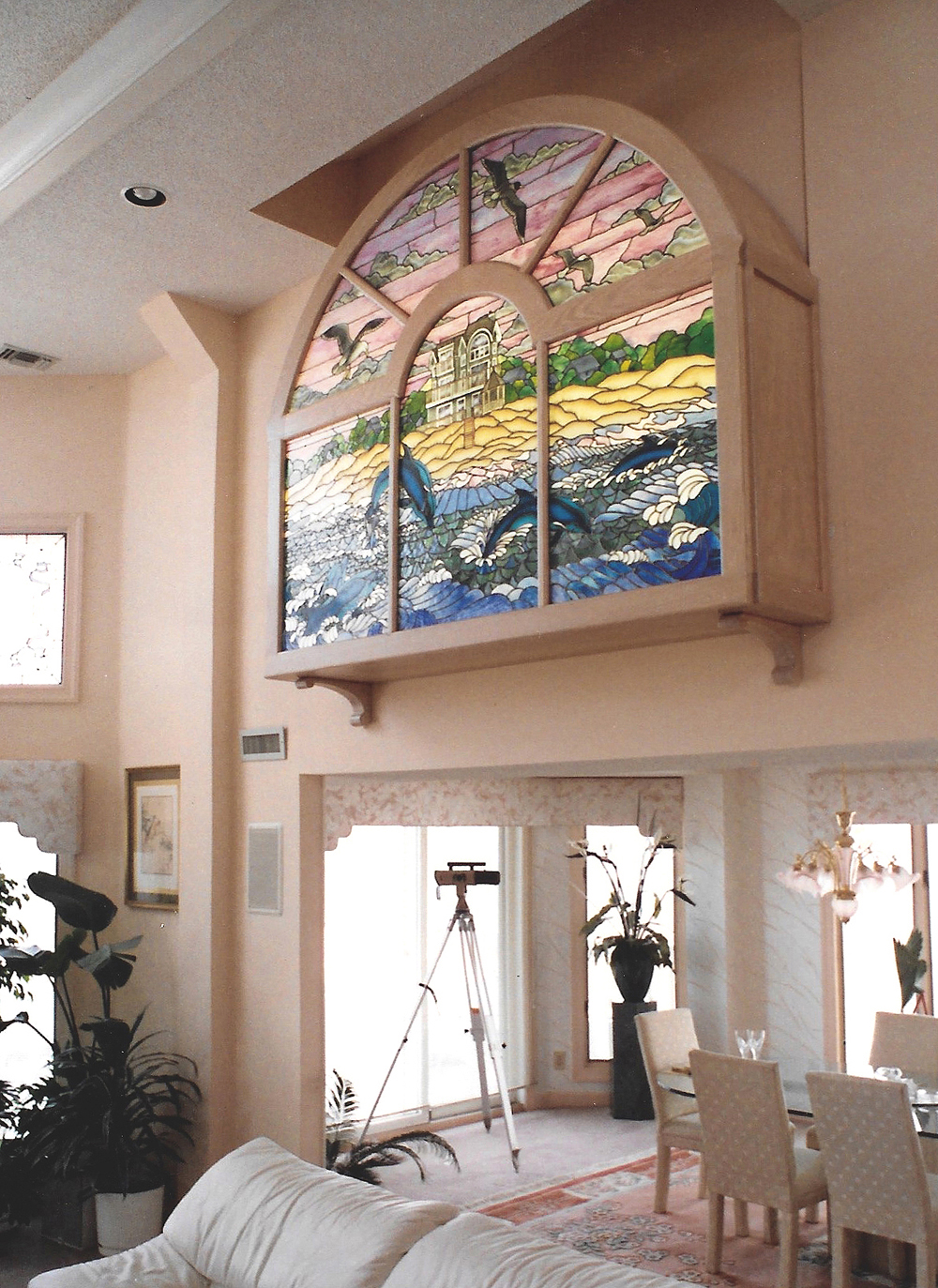
A sunroom, with Art Glass also doing the window framing and cladding it with verdigrised copper, as well as making and installing the leaded glass (commissioned by Thomas and Geraldine Nicholson for their remarkable "chateau" in the Algonguin section of Norfolk, where they graciously made Art Glass' workers feel right at home)
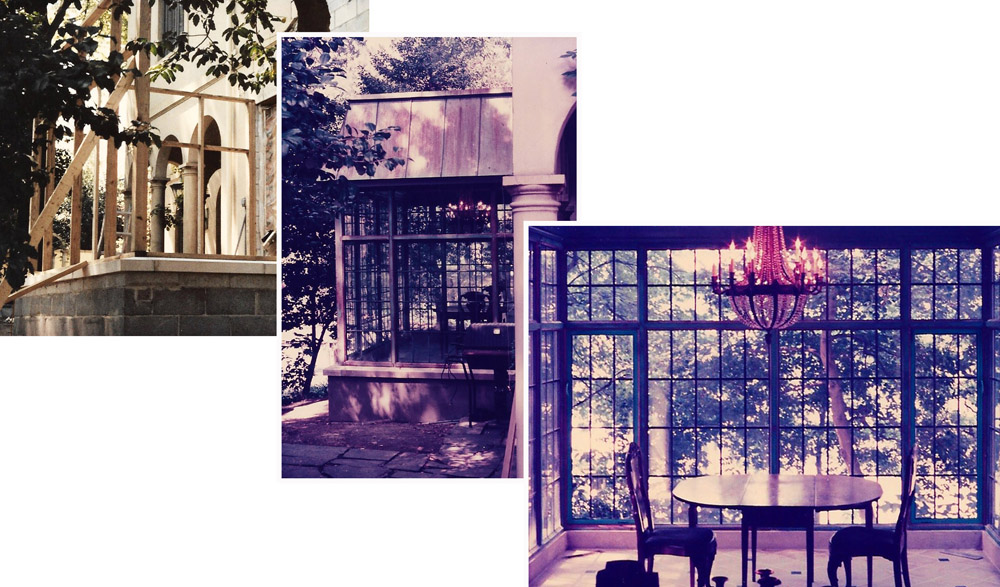
Tarot Cards
Everyone has an idea what the Hierophant's alpha and omega mean, but the B and J of the High Priestess? They're for Boaz and Jachin, the names the Bible gives the black and white pillars at the entrance to the Temple of Solomon.
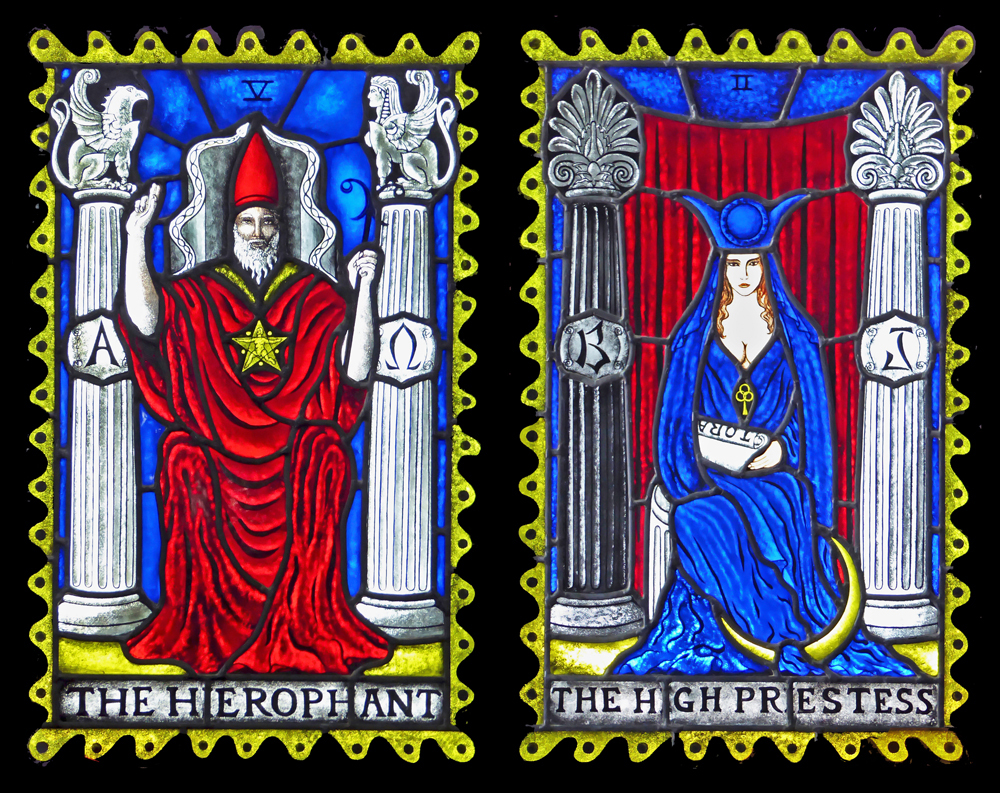
Stained glass, Ray Gregory, Art Glass Resplendent, Norfolk
A layered-panel beach scene
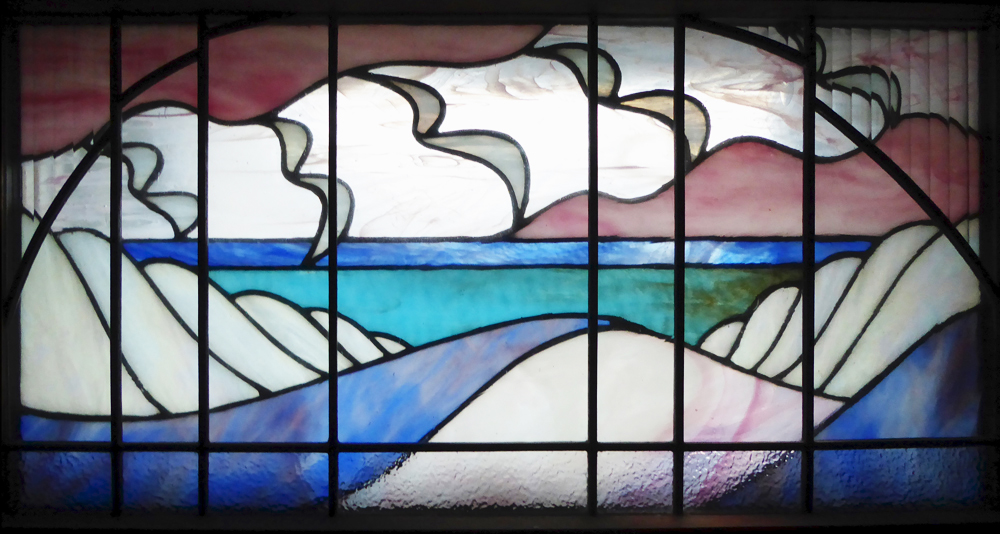
A couple of Ray Gregory's early hobby pieces
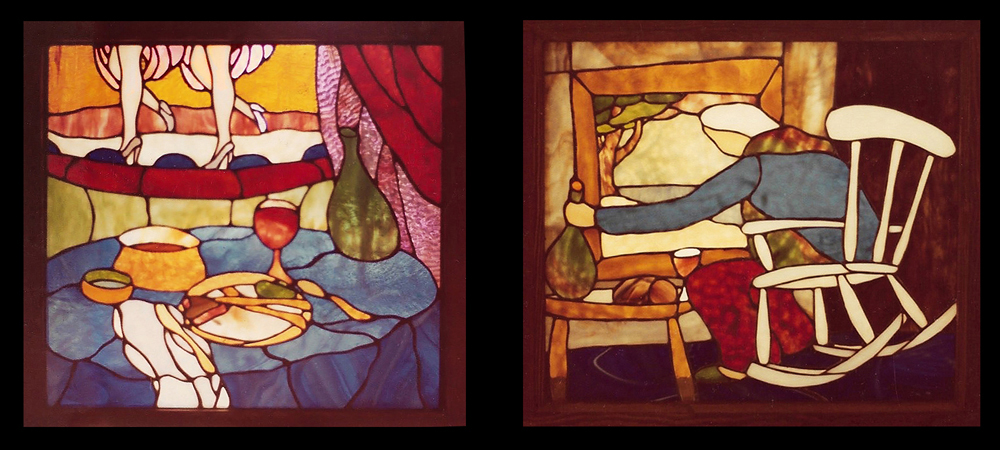
Back to Home Page
|



















































































